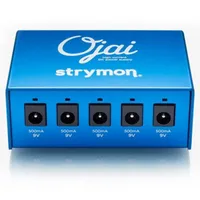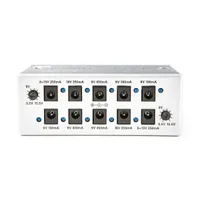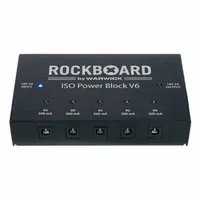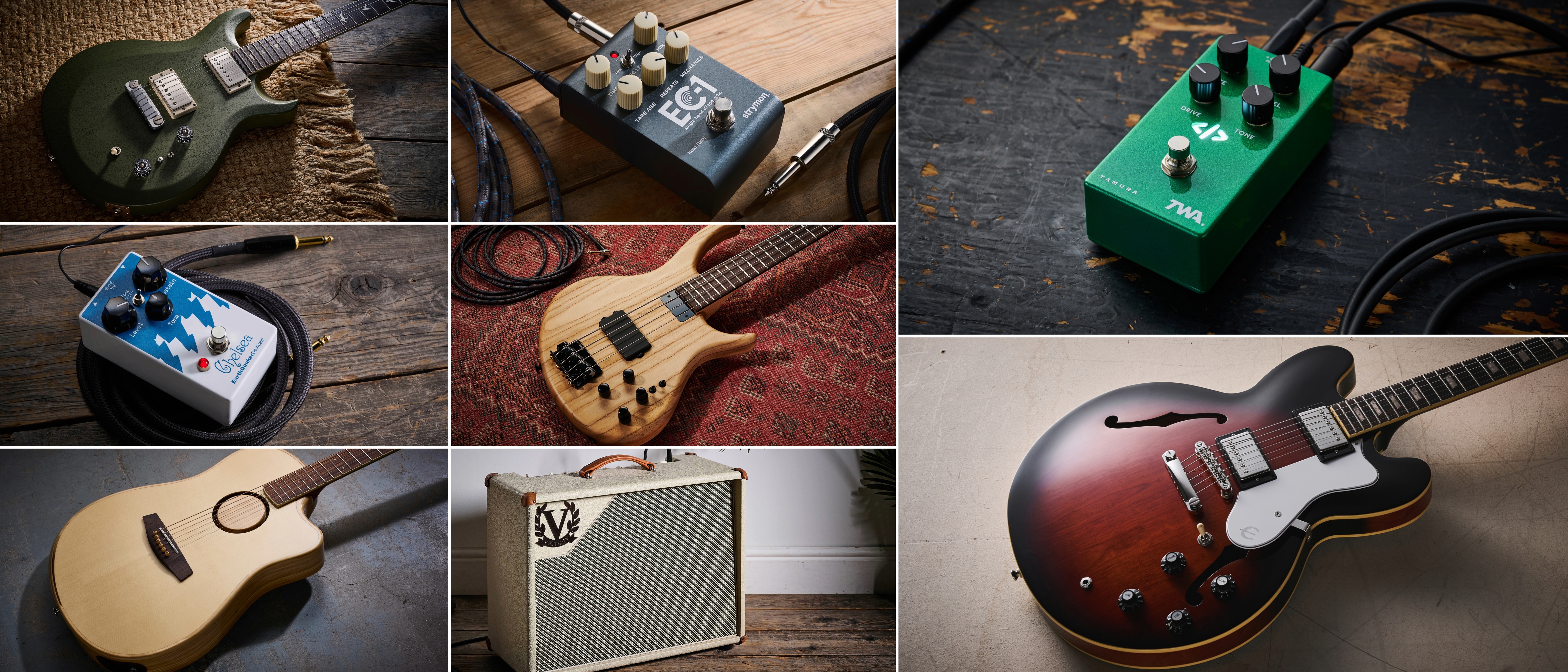Best pedalboard power supplies 2025: juice your ‘board with my pick of pro-grade power, fully tested
I put budget-spanning pedal power supplies from Fender, Cioks, Walrus Audio and more through their paces – these were the standouts
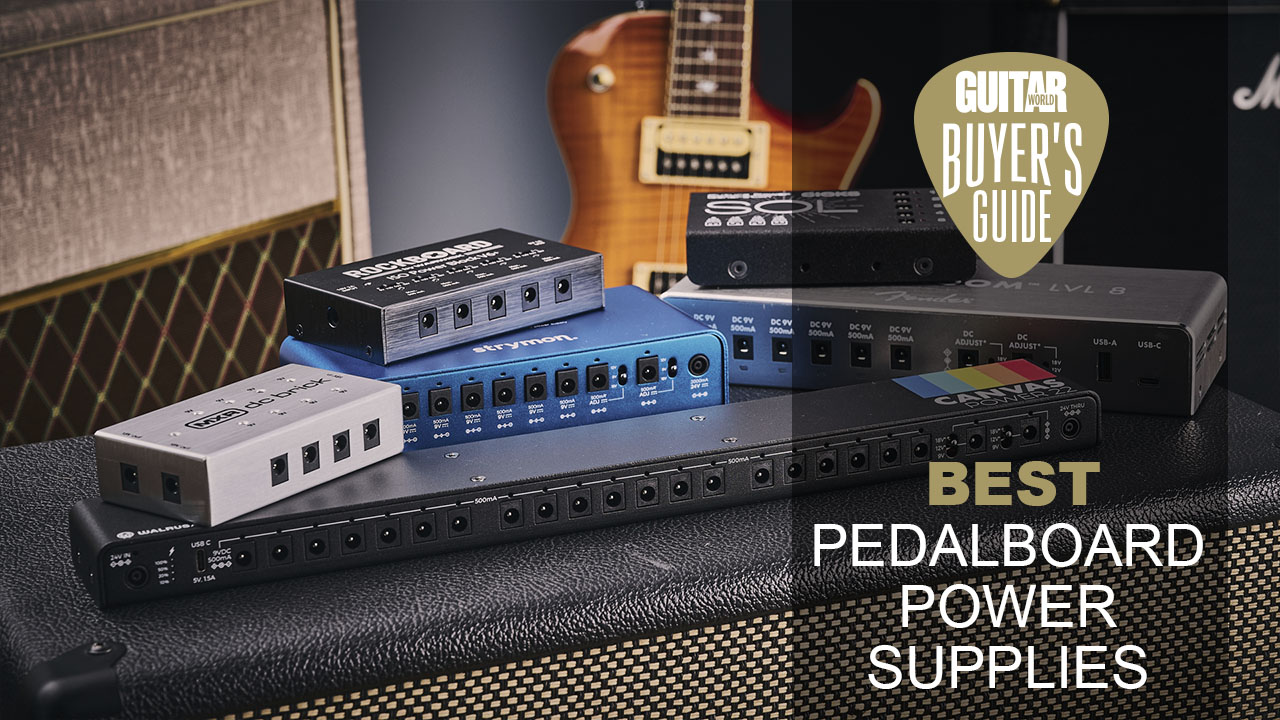
The guitar effects pedal is now a ubiquitous thing, and rightfully so. It’s an eminently accessible portal to sounds of every hue and shade. Indeed, few guitarists haven’t dipped a toe into the world of pedals. But a growing signal chain presents logistical issues alongside sound-scaping potential; how on earth do you power them all?
For a long time, we relied on the good ol’ 9-volt battery to juice our pedals – but the past fifty years have seen ballooning pedalboards, ever-more power-hungry digital effects units and, consequently, significant development in the world of pedalboard power supplies. Rather than changing a dozen batteries before each gig, you can instead entrust your pedals’ active circuitry to a single juice-providing unit.
The best pedalboard power supplies are true unsung heroes, no matter the size, shape or intent of your pedalboard. A power supply can be stashed pretty much anywhere, providing constant, stable and uninterrupted power to each of your pedals all the while. Today’s pedalboards are so much better than those which came before, too – eschewing noisy power lines in favor of clean, isolated power outlets.
I’ve taken a wade through these dense waters, tested a wide range of options and compiled this list of the best pedalboard power supplies you can buy right now. Of the many I’ve reviewed for this guide, one contender emerged as a near-infallible all-rounder: the Fender Engine Room LVL 8. It has high-current inputs for days and variable-voltage outlets for more demanding effects, as well as two USB outlets for impromptu device charging or pedal lighting. It’s a great option for the average pedalboard, with enough behind it to power several analog pedals from one outlet if you need to expand beyond the available isolated outlets.
On the hunt for guitar gear savings this Black Friday? Shop our handpicked selection of the best Black Friday guitar deals.

“I’m a guitarist of well over two decades, actively gigging and recording for well over a decade of that time. Between my home studio and my shared DIY studio space, I spend a lot of time writing and recording for myself and for other bands. Between hectic live-show soundchecks and clinical studio overdub sessions, I know the value of a good, robust and, above all, quiet pedalboard power supply.”
How I tested: Each of the power supplies in this guide became central elements of my guitar rig – at home, in the studio and during live rehearsals for bands and projects. I evaluated each for how well they were manufactured, how easy they were to set up, how readily they filled their own brief and how quiet the rigs they powered were. Read more about how I tested the products for this guide.
My top picks
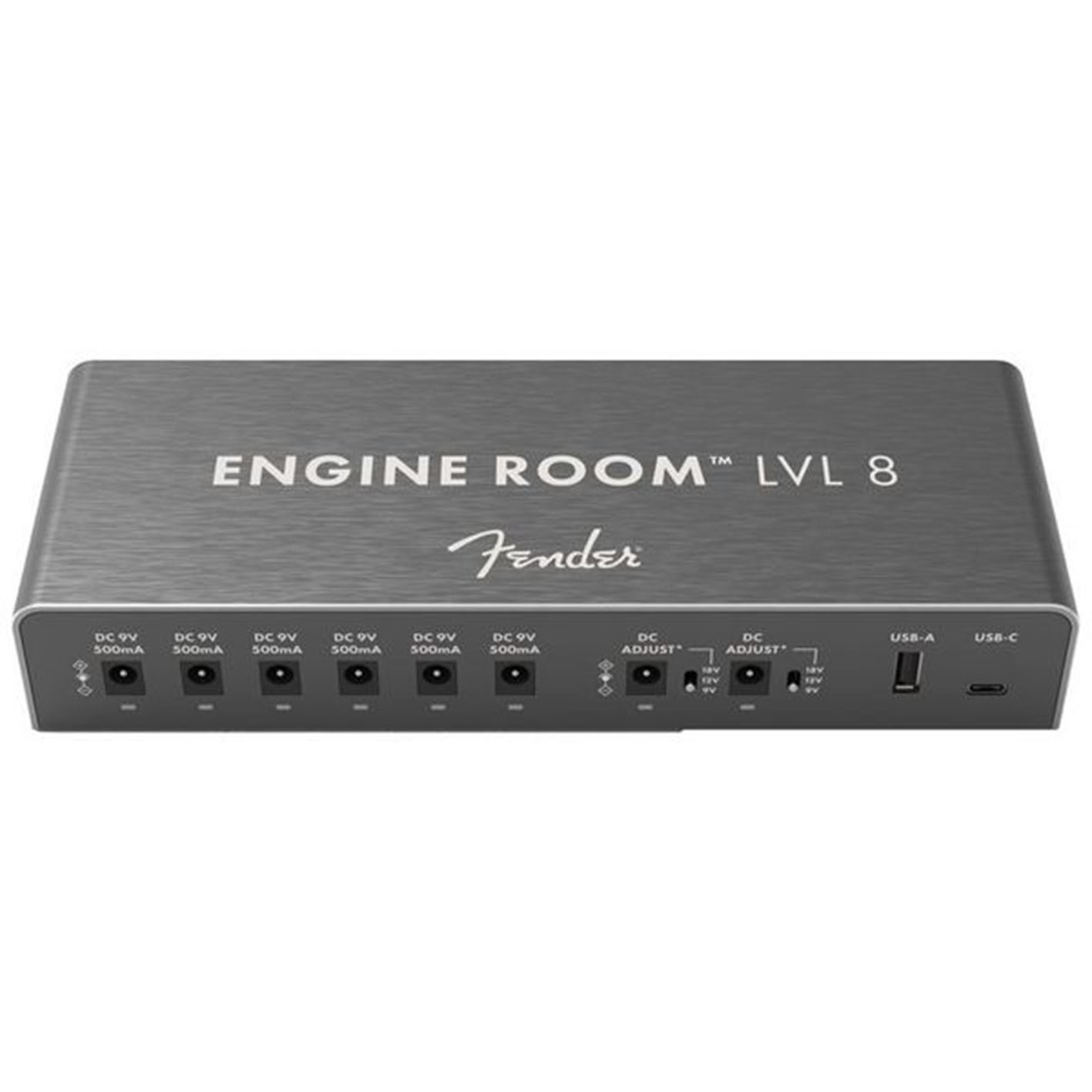
Fender’s Engine Room series is criminally overlooked amongst power supplies, and not just for those swanky brushed-aluminum looks either. The LVL8 is the mid-range entry, with eight isolated outputs – two of which can be switched between 9, 12 and 18V. The two spare 5V USB outlets are the icing on the cake for this robust and versatile piece of kit.
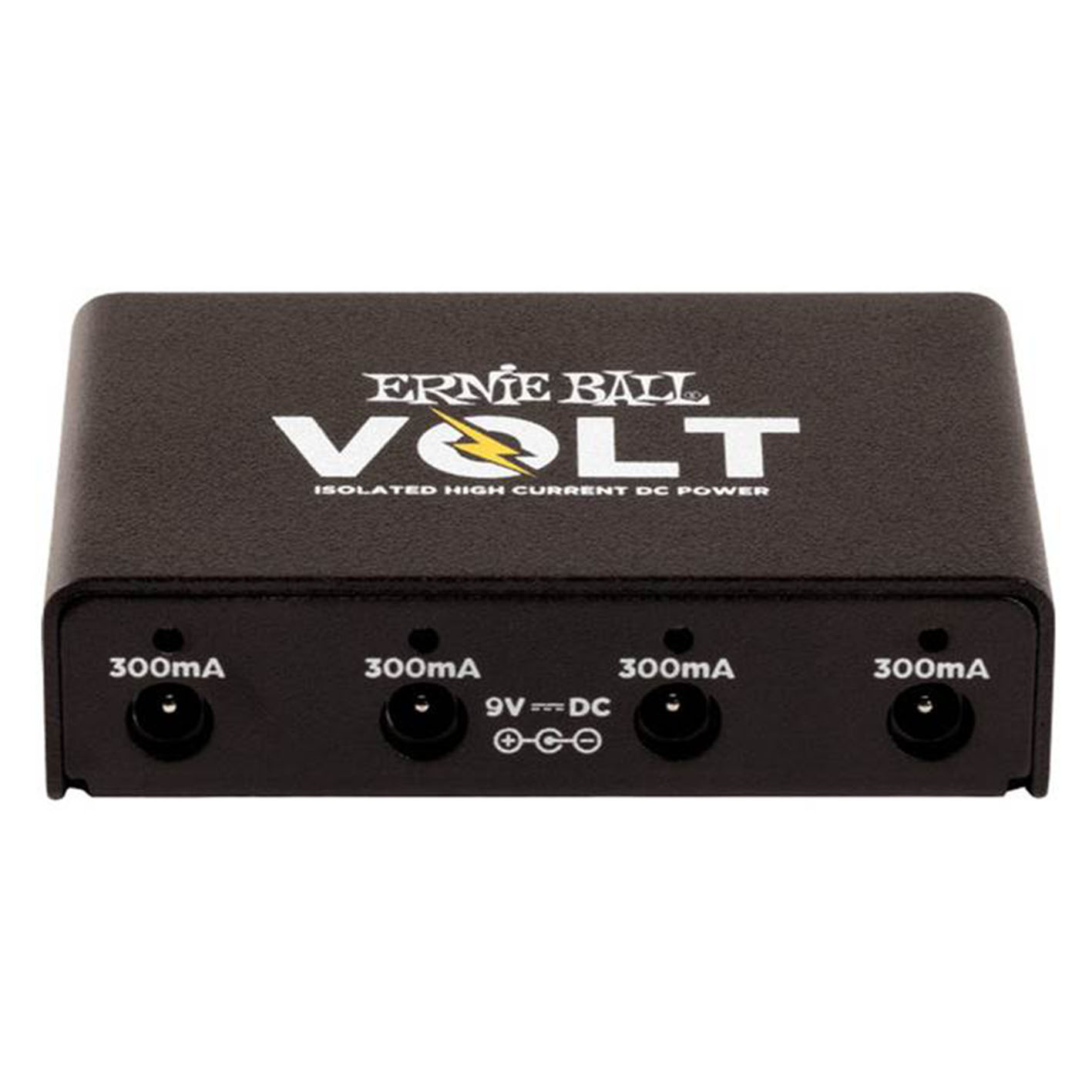
If you don’t have much to spend on pedal power, Ernie Ball’s Volt is a fantastic option. You get a miniscule power supply with four high-current isolated outs – and the option to expand it by daisy-chaining another on, if you need. A great shout for those newer to pedals, and just as quiet as power supplies twice the price.
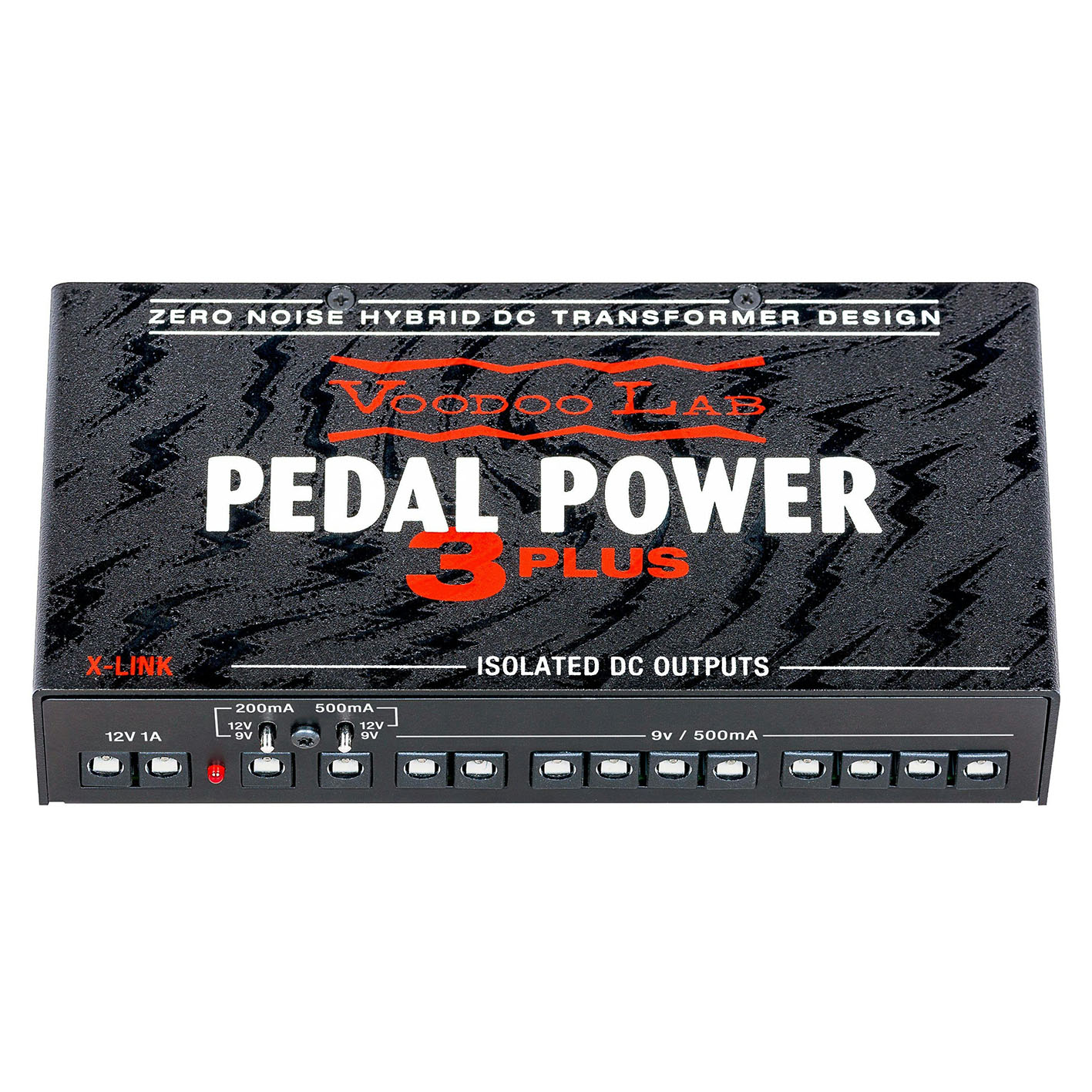
Voodoo Labs’ power supplies are frequent fliers on your favorite guitarists’ touring pedalboards, and for good reason too. The Pedal Power 3 Plus is a well-equipped power supply that’s built like a tank, ensuring solid performance and some comforting resilience against the rigors of the road.
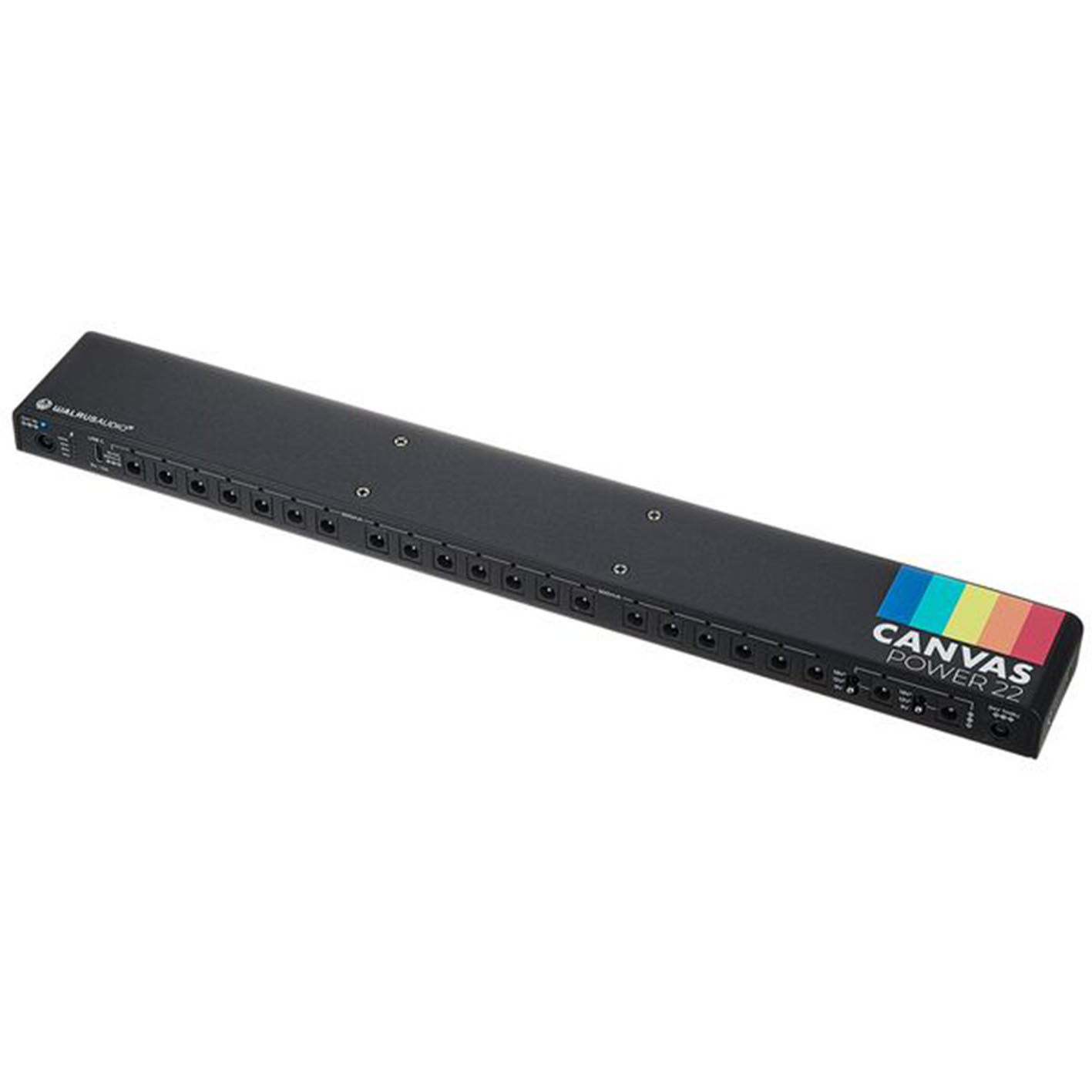
This is, frankly, an insane piece of equipment. Walrus Audio’s Canvas Power 22 is the largest of the Canvas-series power supplies, and an extremely feature-rich baton of pedal power too. Isolated outputs, switchable outlets, link outlets for expanding your pedal-powering capabilities… This is the be-all end-all power supply for the true mothershippers out there.
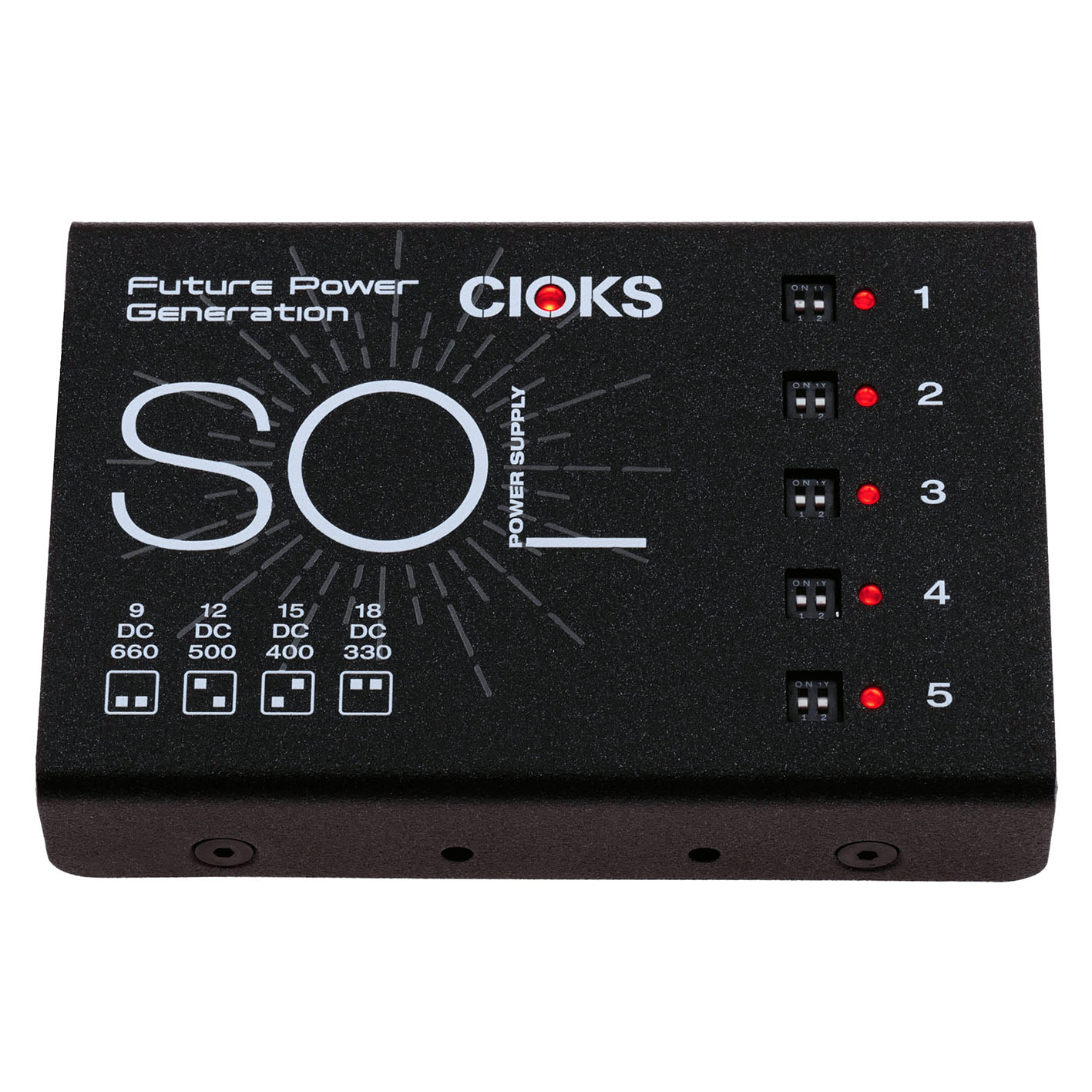
Cioks’ Sol power supply is a godsend for the multifarious guitarist. It’s low profile, switch-mode and IEC-powered, making for minimal bulk on or around your board; it’s also extremely adaptable, becoming hugely handy in every situation from live shows to hanging out on your home studio desktop.
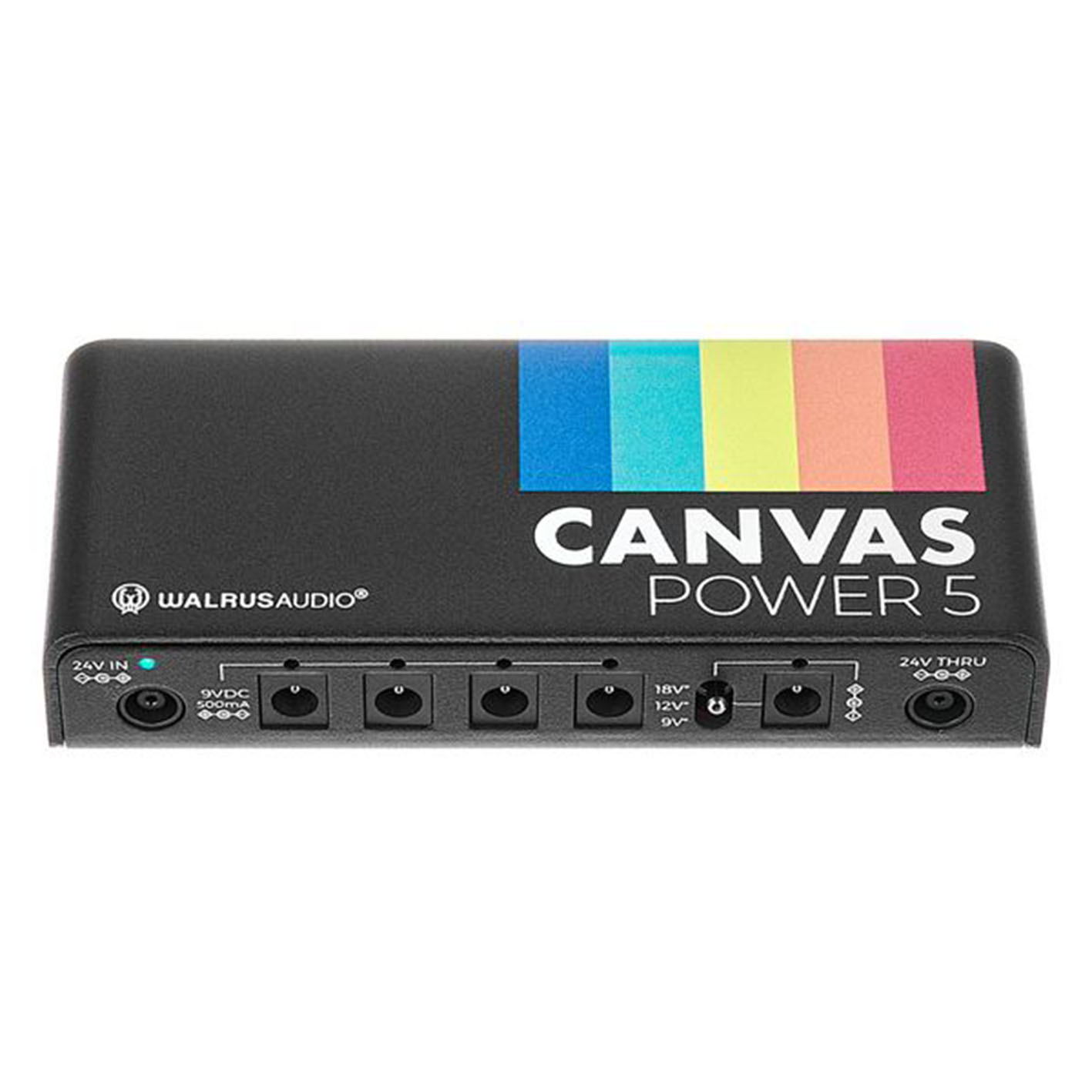
The Canvas series as a whole is fantastic for modular pedalboard-ing, but it’s the Canvas Power 5, 5 Link and HP models that illustrate this best of all. These handily-sized power supplies are easy to link up to one another, enabling all to be powered from one plug – and enabling you to easily chop and change your rig without fuss.
Best overall
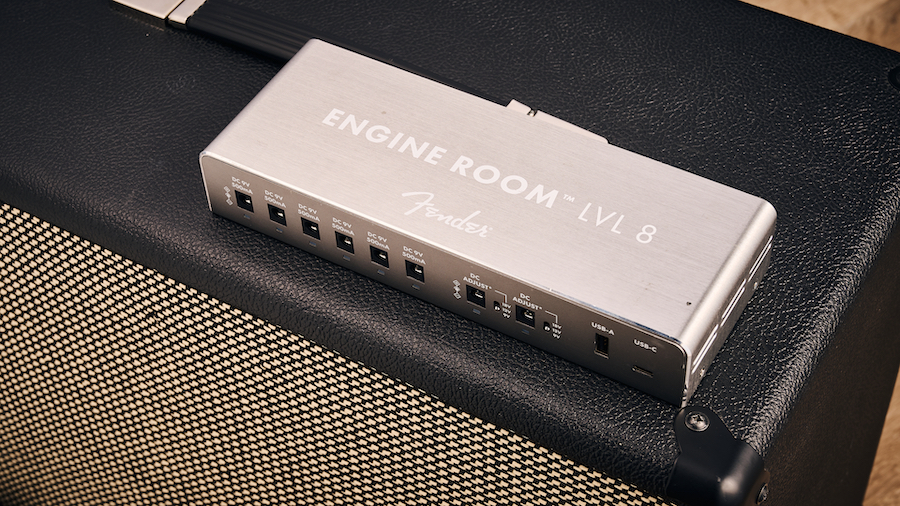
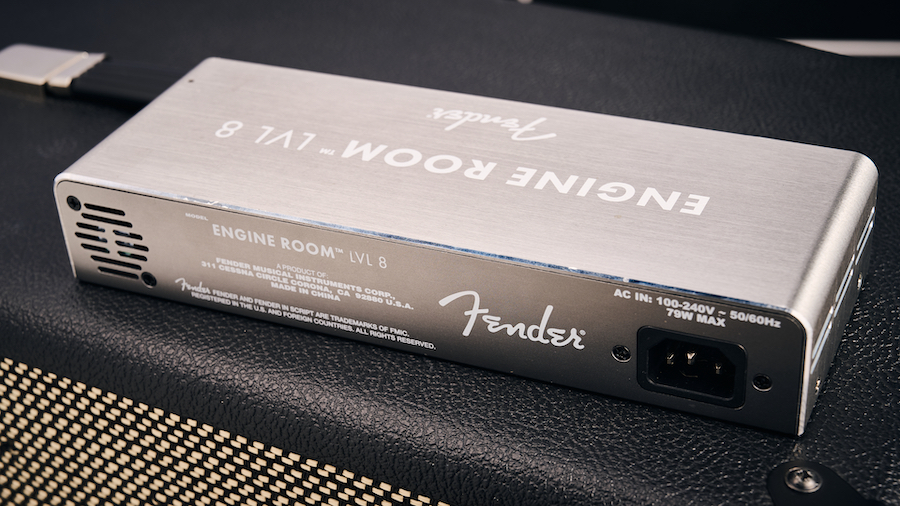
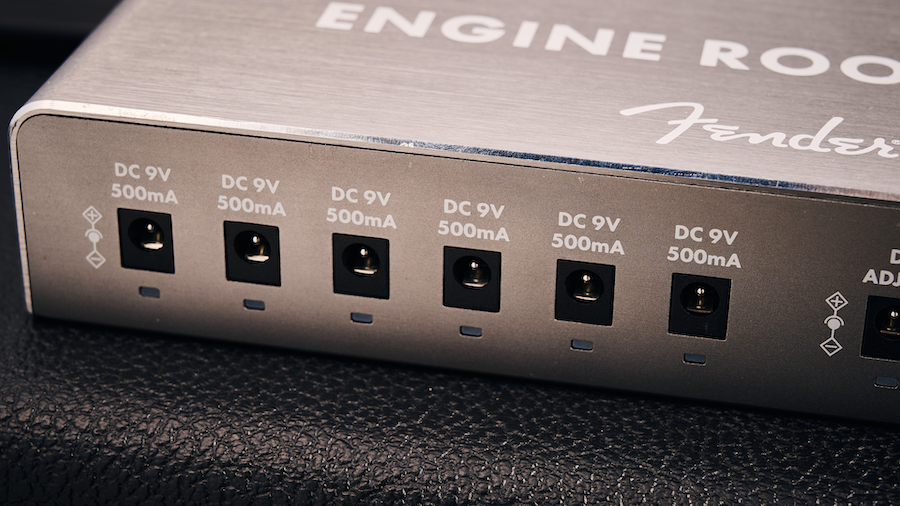
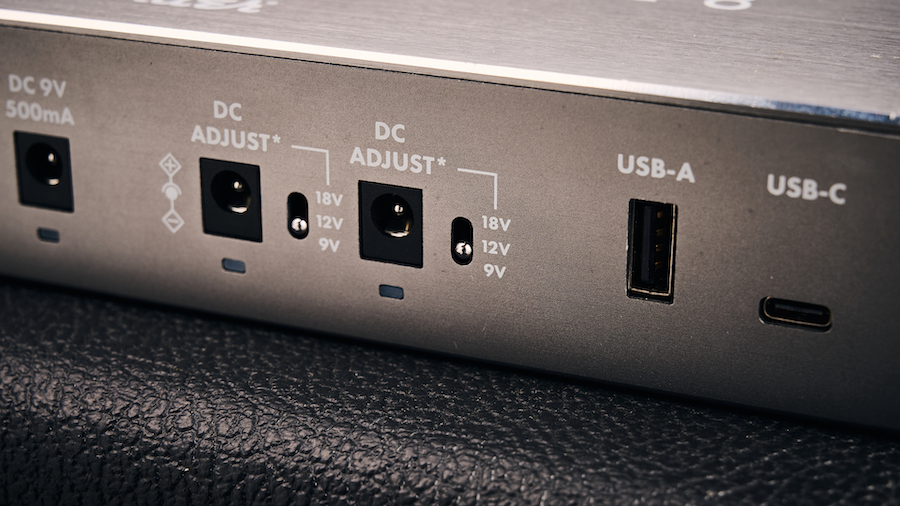
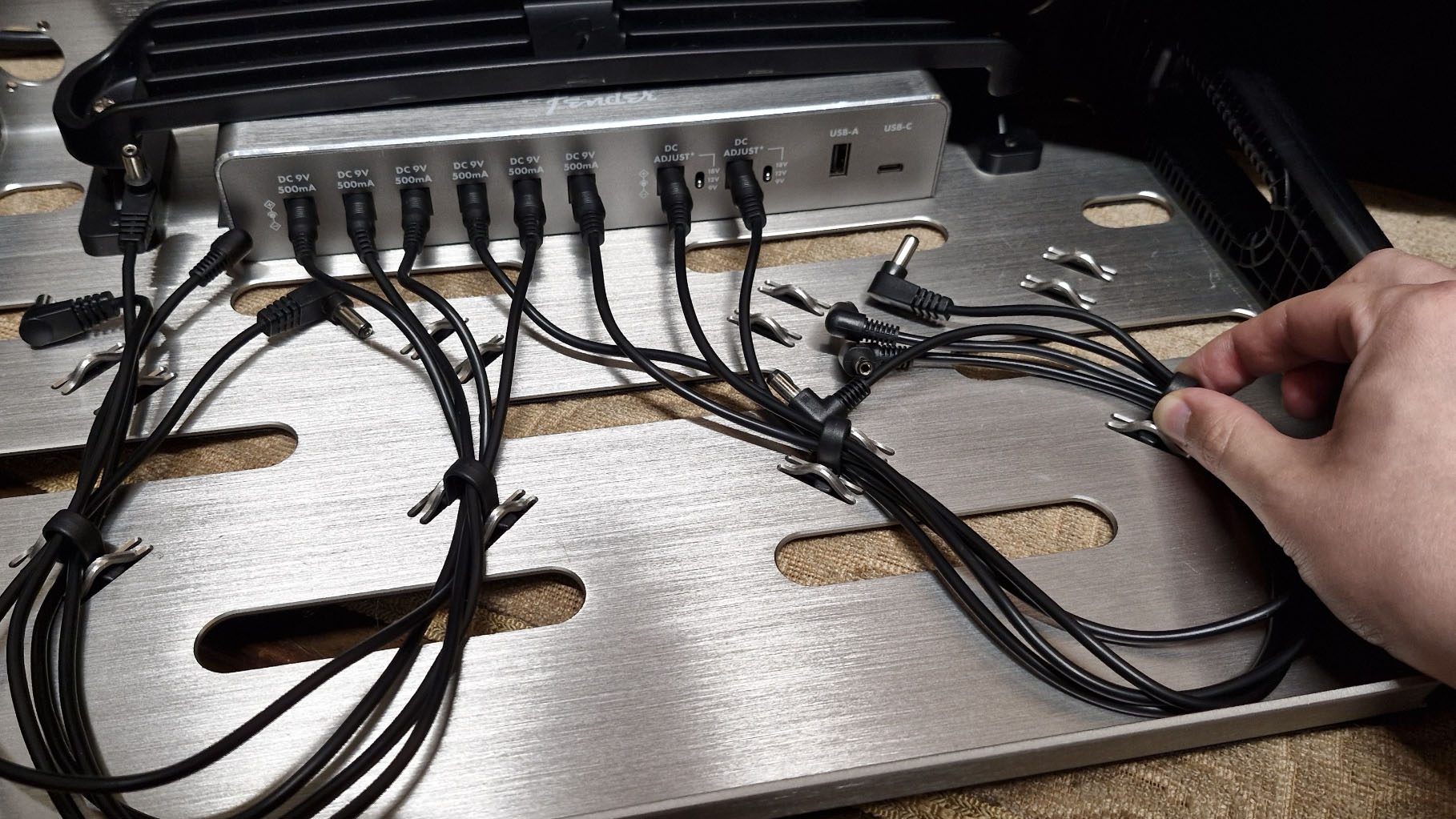
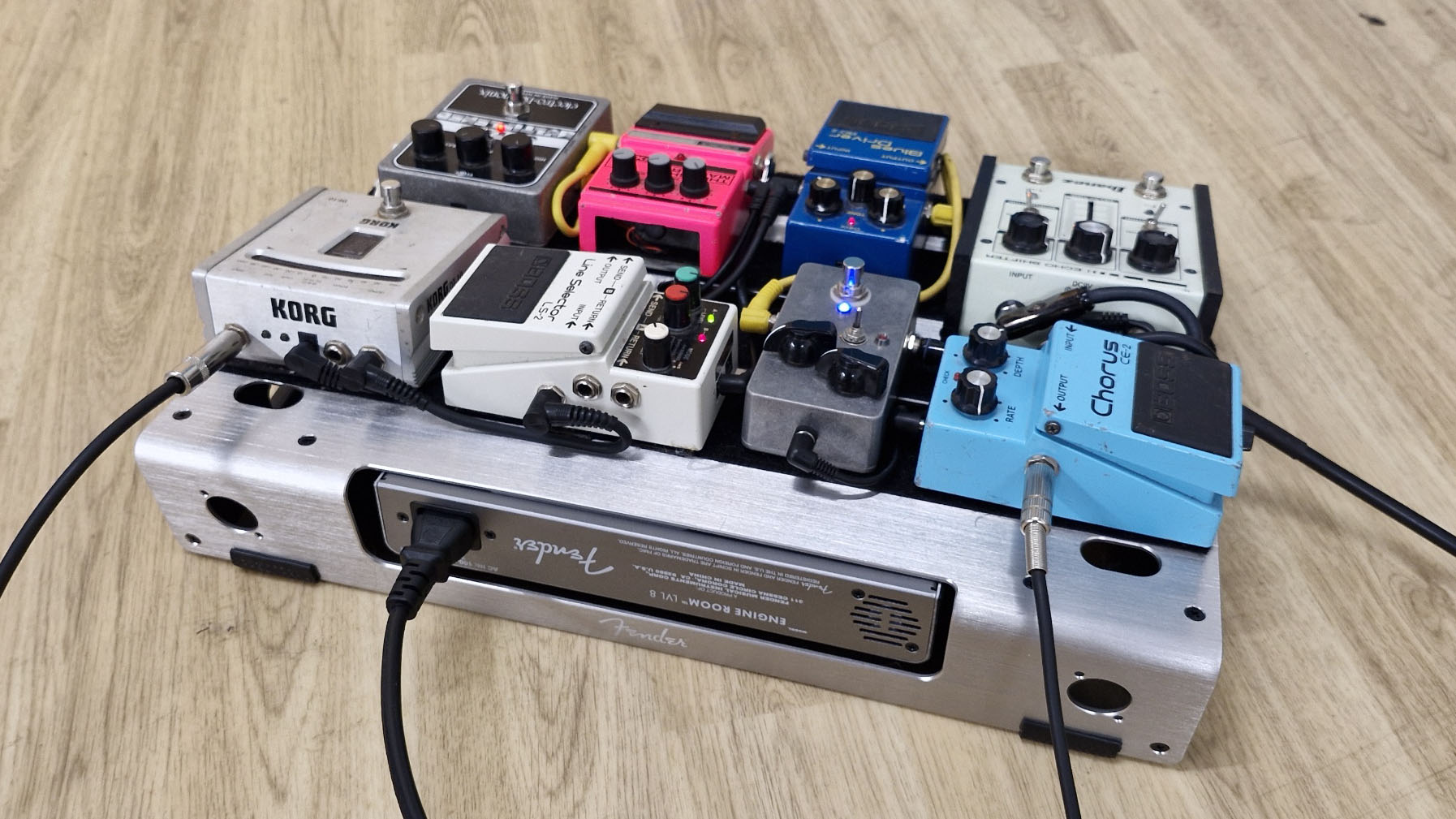
Specifications
Reasons to buy
Reasons to avoid
✅ Buy if you have an average-sized pedalboard: The Fender Engine Room LVL8 is a great midway point that will suit the vast majority of guitarists. I love that it also has a couple of USB outs too.
❌ Avoid if you don't have much space: It's quite bulky compared to some more compact options here, so avoid if you've not got much room under or on your 'board.
What is it? Fender’s Engine Room series is a range of highly-practical pedal power supplies, designed to service pedalboards of increasing complexity with minimal fuss or intervention. This is the middle child, the Engine Room LVL8; it charts some incredibly useful territory, with eight isolated DC outlets and two different USB outlets for powering pedalboard lights and emergency-charging your devices mid-tour – but simultaneously.
Build quality: With a complete aluminum enclosure, this power supply is built like the proverbial outhouse. It’s bulky, weighty and reassuringly hefty; there’s no chance this thing isn’t taking a beating like a champ, though that aluminum finish may wear the resulting scars a little proudly.
The tolerances on the chassis’ parts are rewardingly tight, too; the Engine Room LVL8 certainly talks the talk just as much as it walks the walk. Strategic cutouts in the enclosure ensure the insides don’t get too toasty, too. With the Engine Room, it’s just nice touch after nice touch, from the beveled edges to the recessed USB ports to the individual effect LEDs.
Key features: The Engine Room LVL8 is the mid-sized iteration of the range, featuring eight independent and isolated pedal power outlets. Six of these are high-current 9V outlets, offering 500mA of current apiece; the two remaining are switchable between 9V, 12V and 18V. I find this to be a decent amount to offer for the average guitarist, either wanting to power something special in their chain or provide a little more headroom to their pride-and-joy overdrive pedals. The power supply takes an IEC lead too – so no bulky plugs to carry around with you.
Performance: For much of my testing, I was running a stereo rig for a two-piece noisyband, with one octave-down output destined for a bass amp and another sent to a Fender Twin Reverb. Previous iterations of the same signal chain have been hissy, touchy and even straight-up buzzy, but the Engine Room provided blissfully noiseless power to my amps. The extra USB ports were far more useful than you might think, too! Far from just being a chance to power a superfluous pedalboard lamp, they also enabled some emergency phone-charging – a literal lifesaver during one crucially important pre-gig rehearsal.
Final verdict: The Fender Engine Room LVL8 is a great-looking pedal power supply that does everything you’d hope and more. Between the high-current outlets, the duo of vari-voltage outlets that facilitate difficult equipment, the comes-in-clutch pair of USB outputs and those fabulous beveled edges, it’s hard not to recommend this as the ideal all-rounder pedalboard power supply.
Best budget/compact
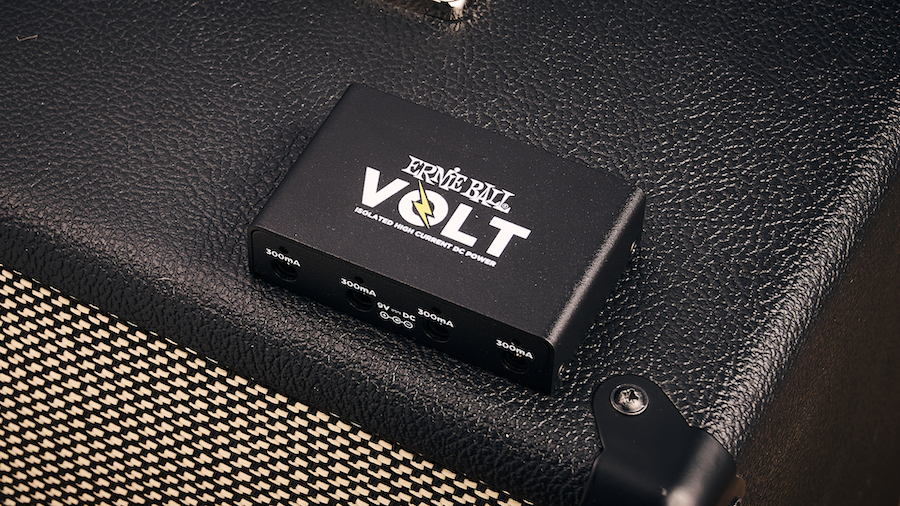
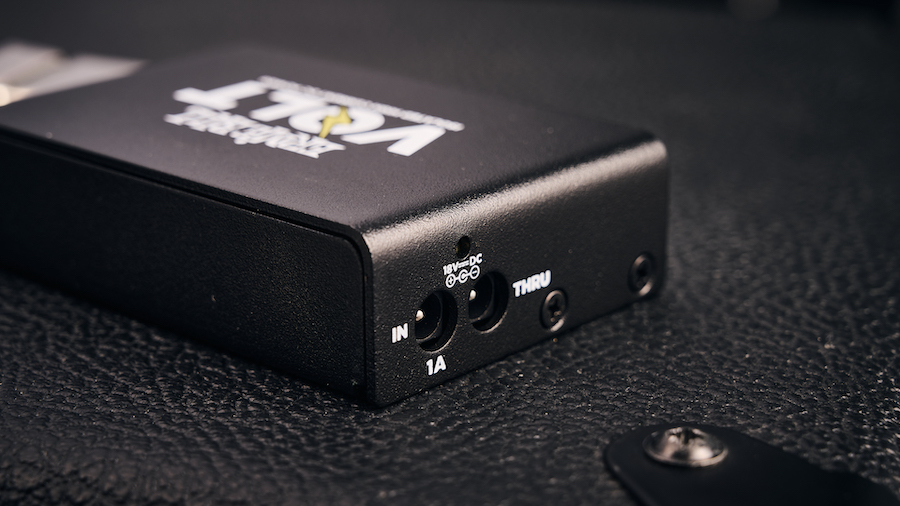
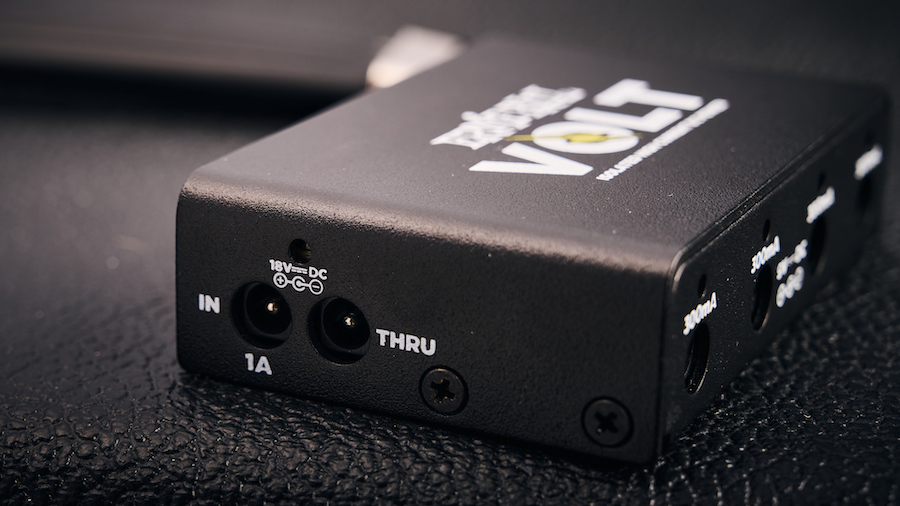
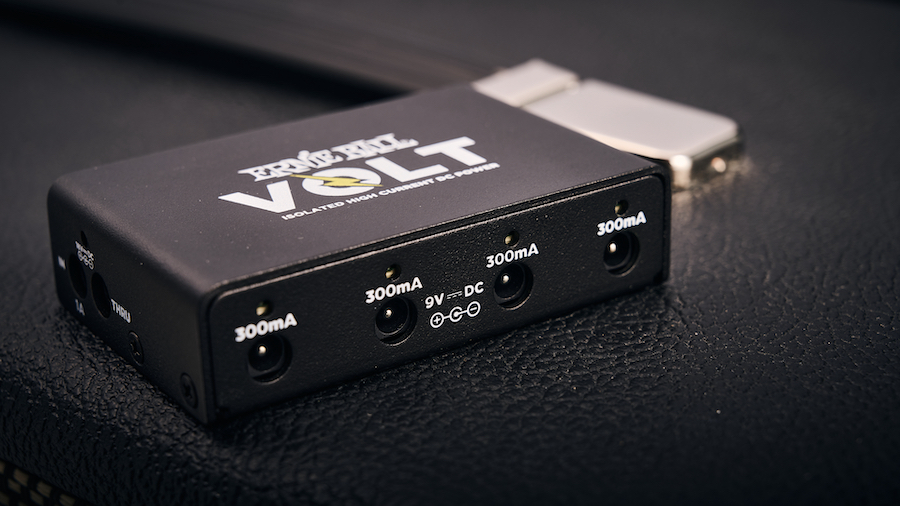
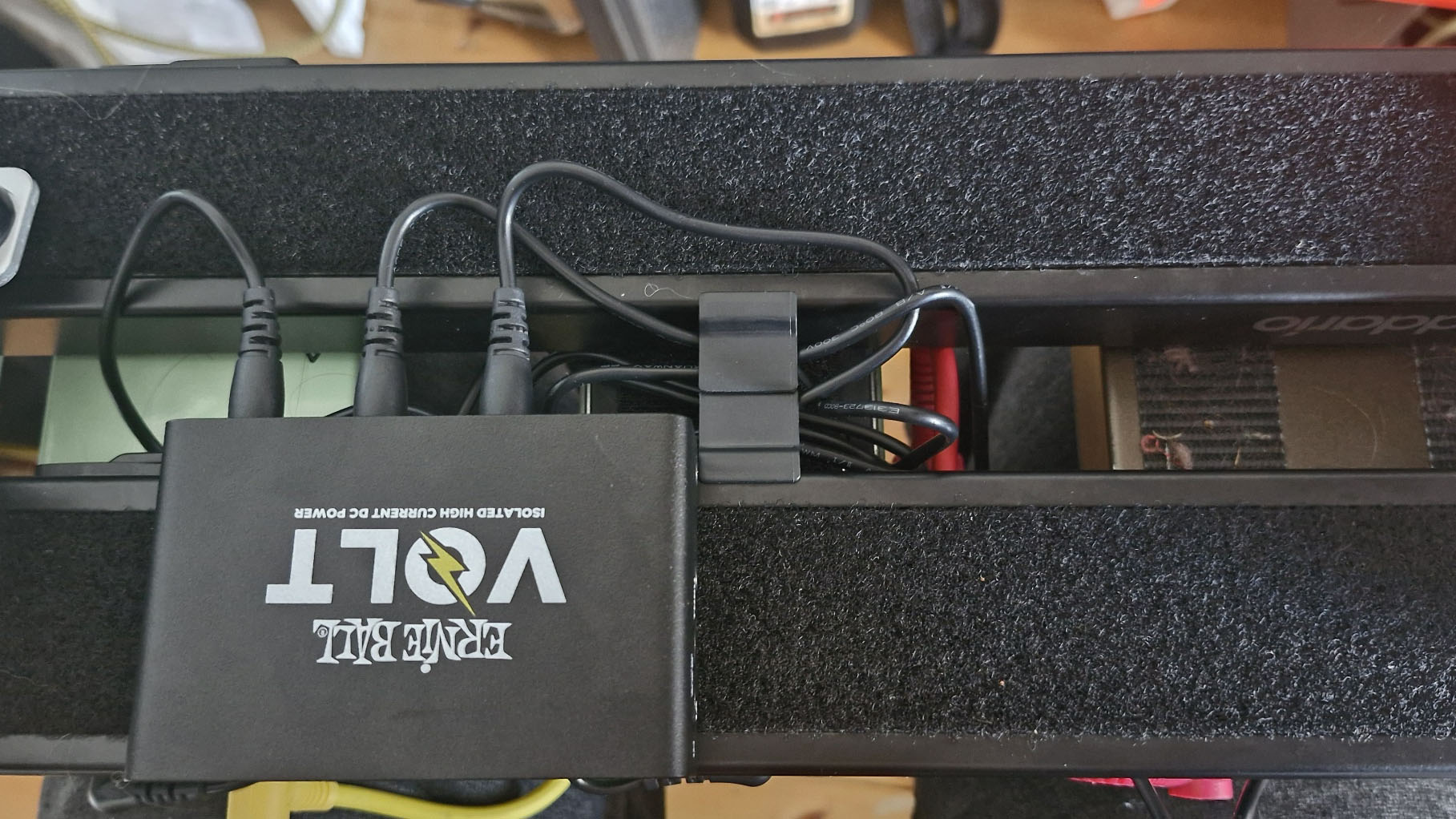
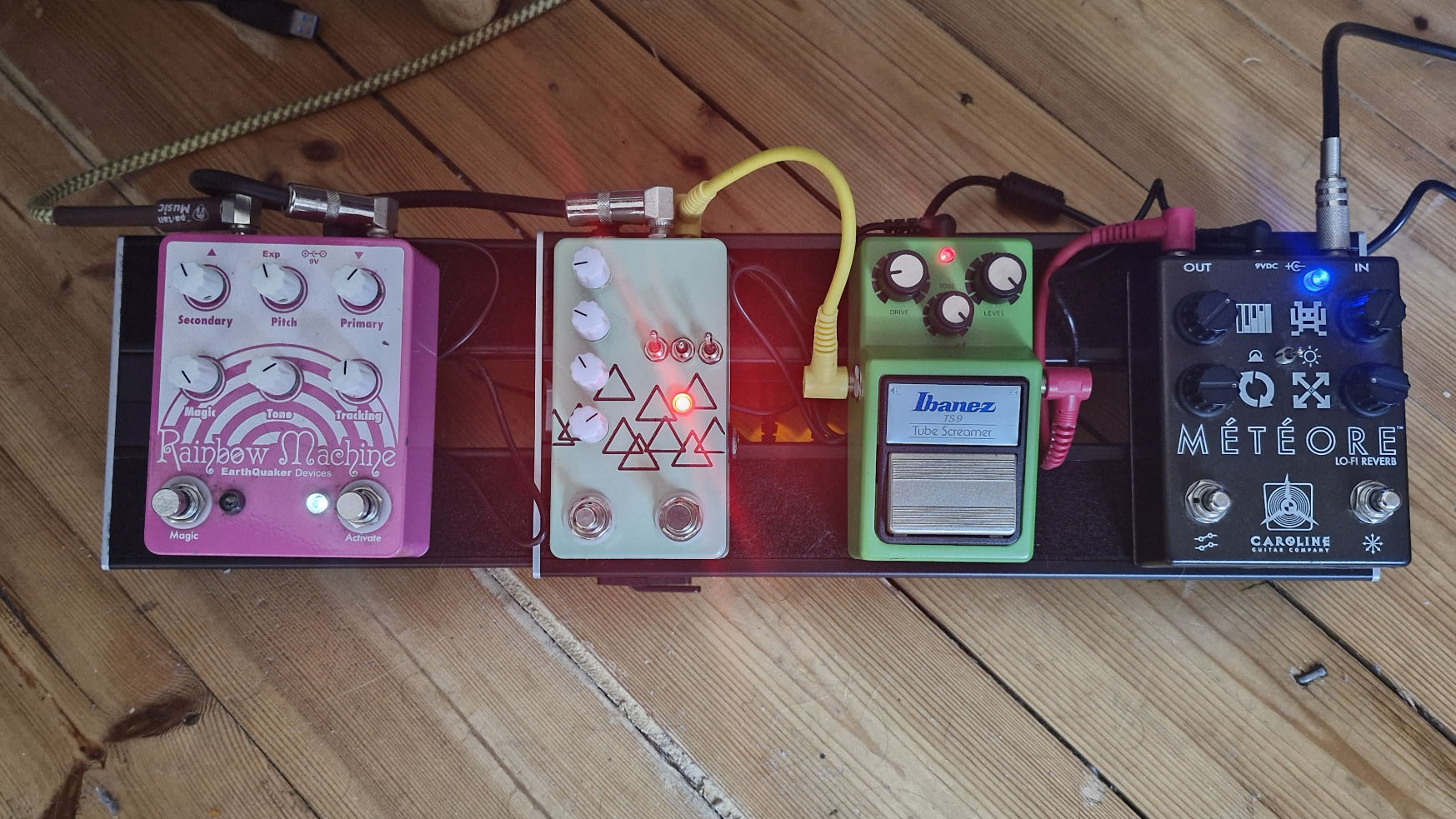
2. Ernie Ball Volt
Our expert review:
Specifications
Reasons to buy
Reasons to avoid
✅ Buy if you have a small pedalboard: The Ernie Ball Volt is the ideal choice for users who only have a handful of pedals, with four outputs.
❌ Avoid if you use power-hungry digital pedals: There's no high current outputs here, so look elsewhere if you need to use digital pedals.
What is it? The Ernie Ball Volt is a seriously dinky little pedalboard power supply, which brings four isolated, high-current 9VDC outputs and an 18V throughput in a box about as small as a deck of cards. It’s a magic trick of all its own that those isolated outs can fit in something so small, to be sure.
Build quality: There isn’t much to the Ernie Ball Volt, on a literal, physical level. But what is there is dense, solid and certainly not going to suffer for the drops, bangs, dings and otherwise cavalier behavior it’s likely to experience during its life. I expect that life to be a pretty long one, too, on account of said solidity.
Key features: For me, the Ernie Ball Volt’s key feature is its incredibly small form factor. Four high-current isolated outputs might not sound like much, but four high-current isolated outputs in a box smaller than a tin of anchovies is downright impressive. There’s 18V throughput for daisy-chaining another Volt, or for powering something else high-demand. The power supply is of the universal 100V-240V variety, too, with switchable prongs for different mains socket standards.
Performance: The Ernie Ball Volt has vastly exceeded my estimations as a small-form-factor pedalboard power supply. The wall wart that powers the unit is plenty juice-ful, and the Volt has absolutely no qualms serving the various types of pedal chain I threw at it. Even with three digital pedals plugged in and a handful of analog pedals powered by daisy-chain, there was no discernible noise coming through to my amp or interface.
For testing, the diminutive D’addario XPND 1 pedalboard was my main platform, used primarily at home to build out demos and pre-produce songs. The XPND 1 is quite accommodating for its size, but still a little tight with respect to underside clearance. The Volt turned out to be an ideal choice here, capably nestling itself with room to spare (and without adding much discernable weight in the process).
Final verdict: I initially didn’t expect the Ernie Ball Volt to make it into my top six, understated as it is in the features department – and yet it won me over thoroughly. The miniscule size is a major boon, particularly for smaller pedalboards, either with little in the way of undercarriage or no undercarriage whatsoever. It’s small, it’s quiet; what else do you need?
Best for touring
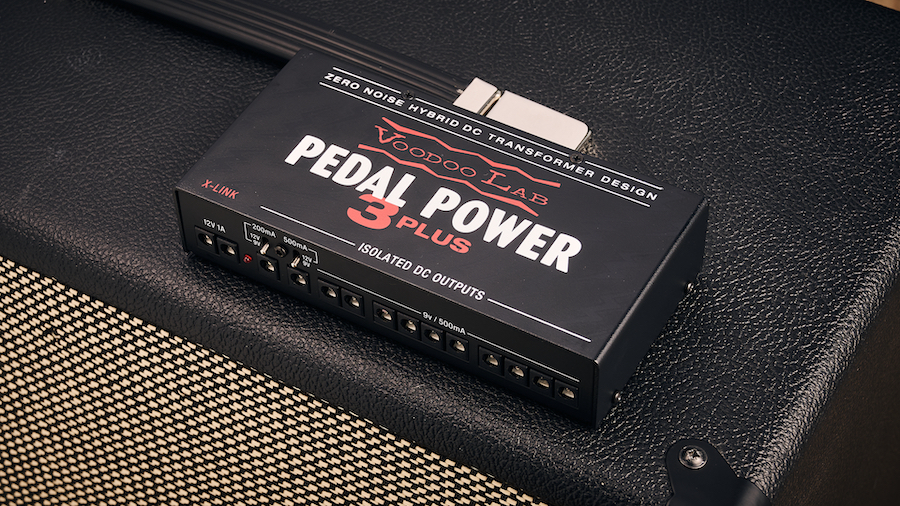
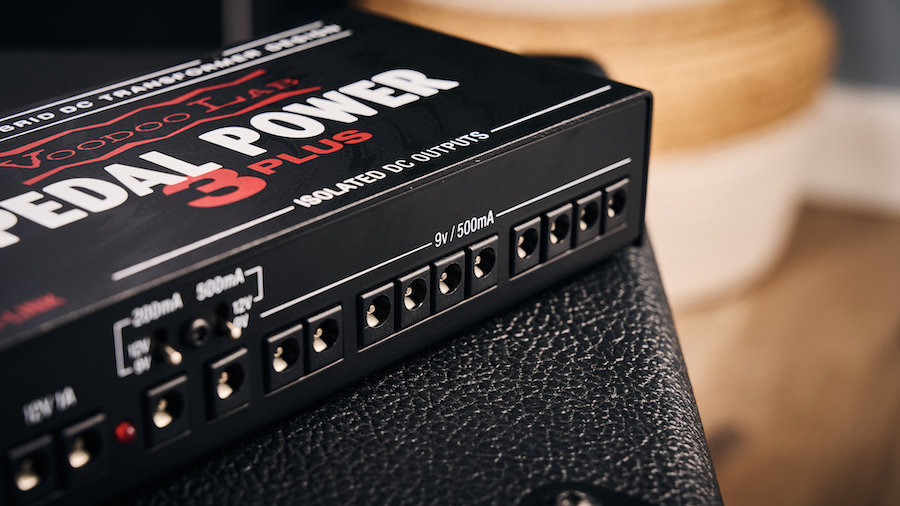
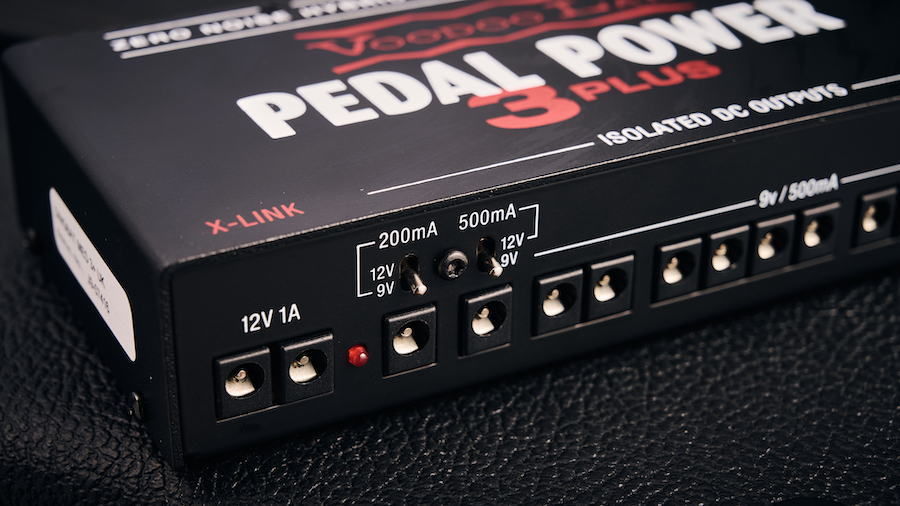
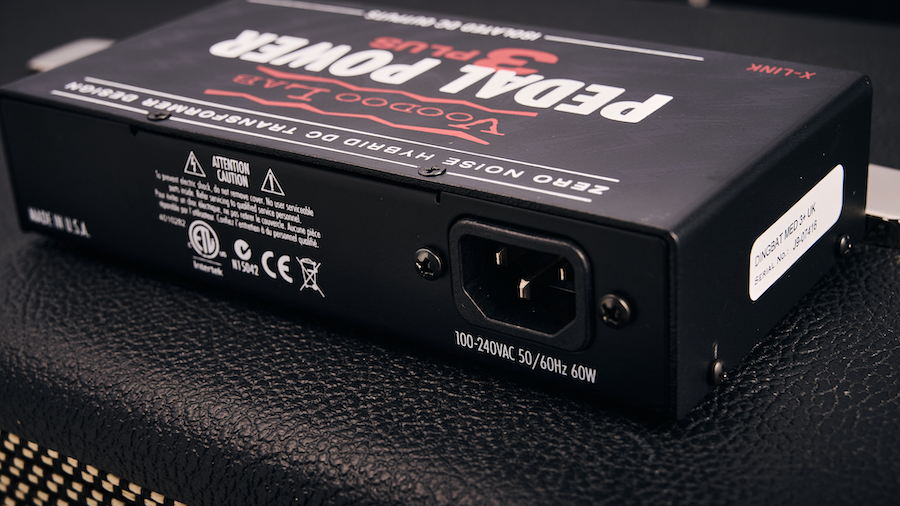
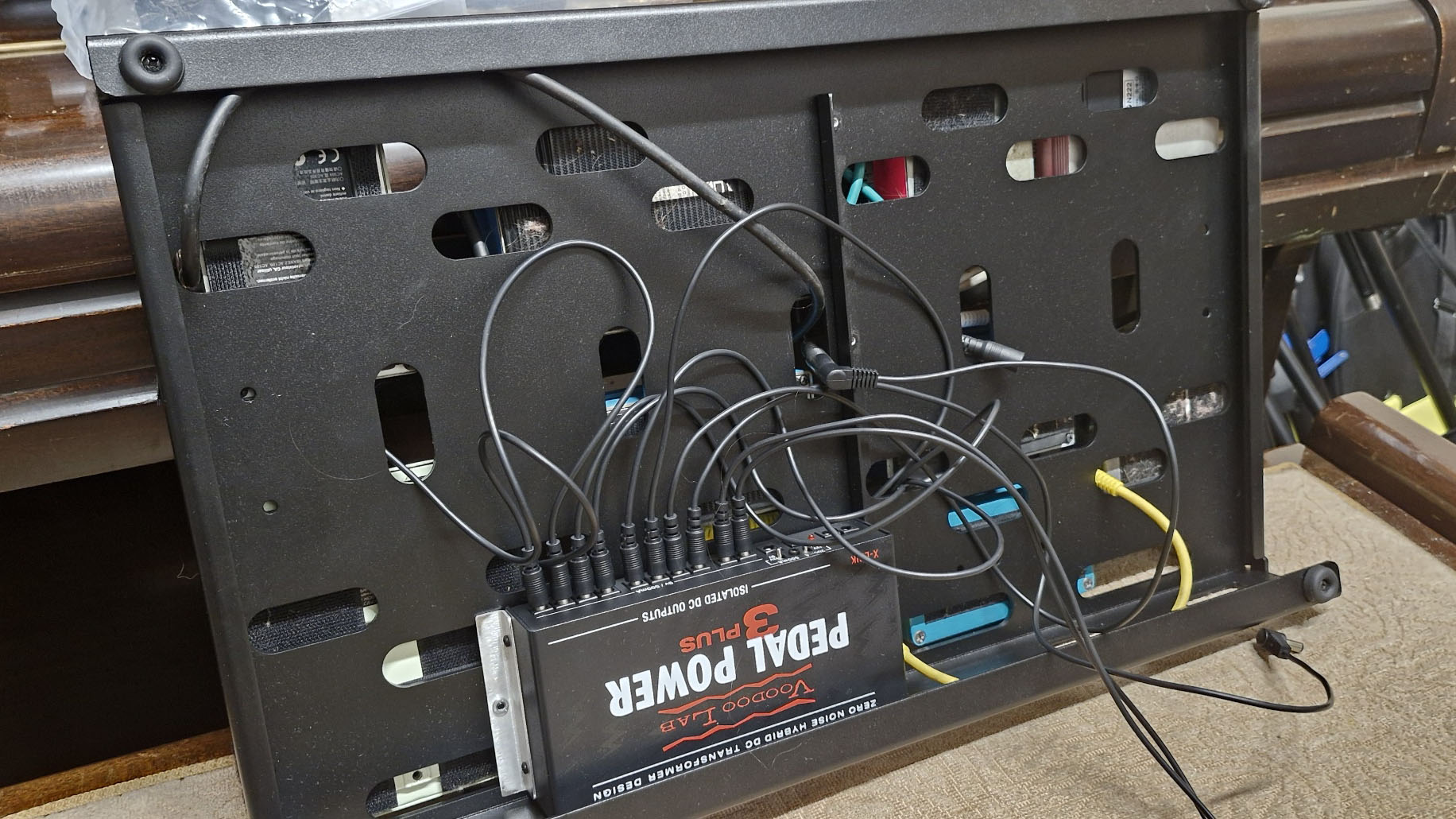
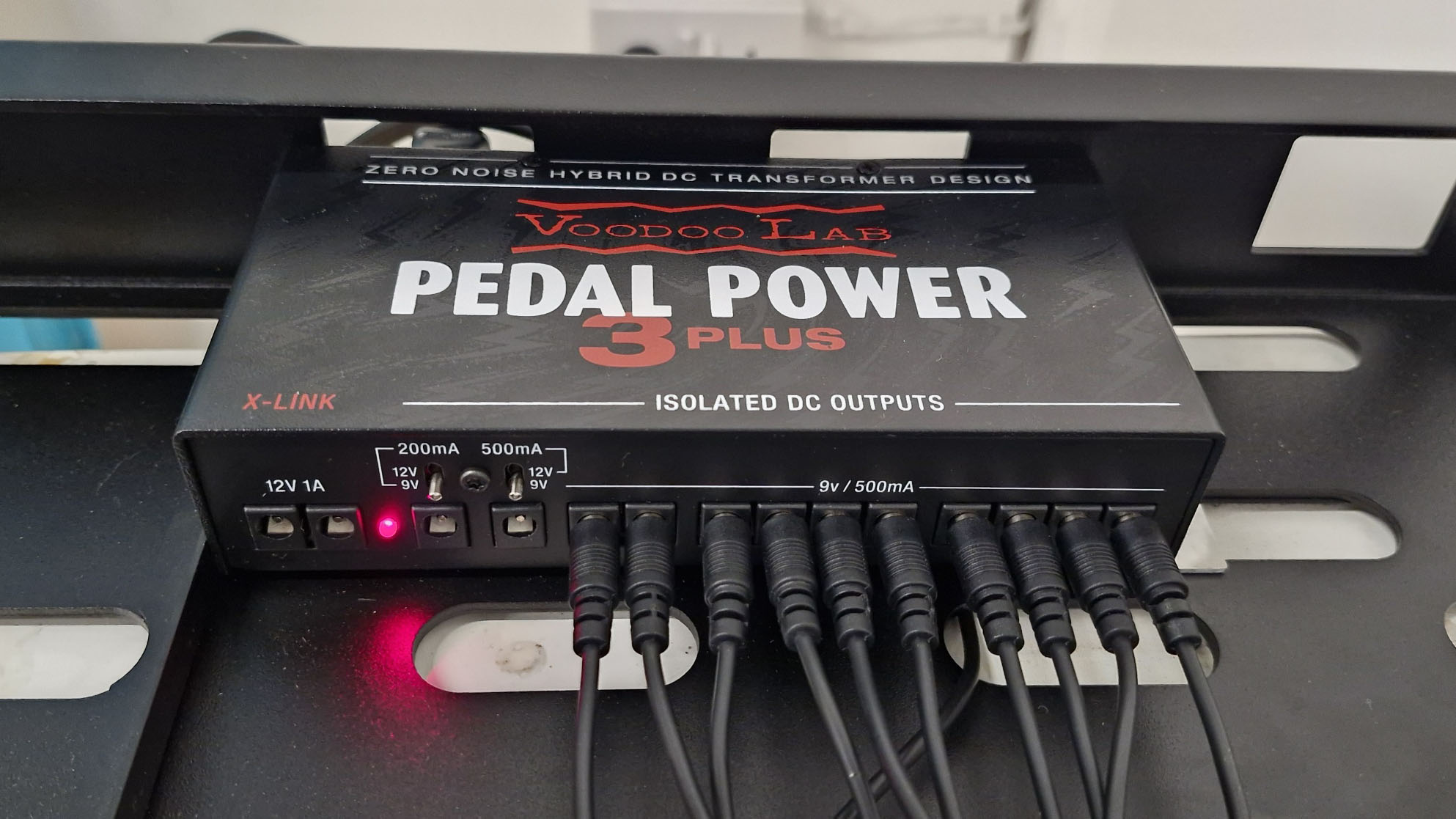
3. Voodoo Labs Pedal Power 3 Plus
Our expert review:
Specifications
Reasons to buy
Reasons to avoid
✅ Buy if you're regularly gigging: The Voodoo Labs Pedal Power 3 Plus is a great shout for touring players, thanks to its robust build quality and plentiful outlets.
❌ Avoid if you don't have a lot of space: Like the Fender power supply, this is a pretty bulky unit so on tighter 'boards you may struggle to fit it in.
What is it? The Voodoo Labs Pedal Power 3 Plus is one of Voodoo Labs’ forefront pedal power supplies, with an expanded number of high-current, isolated outlets for powering your wide variety of pedals with minimal noise interference. It’s also highly synergistic, surprise surprise, with Voodoo Labs’ Dingbat series of pedalboards – easy to mount, easier to use.
Build quality: Voodoo Labs have a great reputation for a reason – and the hefty construction of the Pedal Power series is, at least, part of that reason. My review unit came pre-attached to one of Voodoo Labs’ Dingbat Medium pedalboards, demonstrating some smart design around attachment screw-holes and the resulting sturdiness of the whole package.
Setting it up, I found a reassuringly-firm click in plugging the power cables into their respective outputs, a vice-like grip that’s sure to preserve your pedals’ access to power forever after some unlucky snagging. This thing’s pretty much designed to go the distance with your rig.
Key features: The Pedal Power 3 Plus is ‘Plus’ for the outsized number of power outlets it so gamely harbors. The OG, plain-flavored Pedal Power 3 has six isolated 9V outlets able to provide up to 500mA, two switchable 9V/12V outlets and two ‘X-Link’ outlets that enable you to expand your isolated outs with add-on X-series supplies. The deluxe-edition Plus, meanwhile, has an additional four 9V, 500mA outlets – bringing the grand total to 12 (plus the 2 aforementioned X-Link outlets).
Performance: I used the Pedal Power Plus primarily to juice up a ‘board I was using for writing and recording purposes with a new project; with enough outputs for 12 pedals to be powered separately, I had absolutely no trouble powering my working pedalboard of ten.
My chain comprised a decent handful of often-noisy old-school pedals – DOD’s Thrash Master and PDS 1002 being particularly difficult to tame at times – as well as digital pedals; despite these unholy pairings (which often suffered under lesser power supplies) I noticed no undue noise whatsoever. I’d go as far as to describe the silence in my signal chain as ‘remarkable’, or potentially even ‘miraculous’.
Final verdict: This is a serious piece of pedal-powering kit, from the hefty-yet-mount-friendly design to the serious quietude it all-but guarantees your pedalboard. If I were taking myself cross-country to play some dingy basements tomorrow, I think this would be my touring power supply of choice.
Best for large 'boards
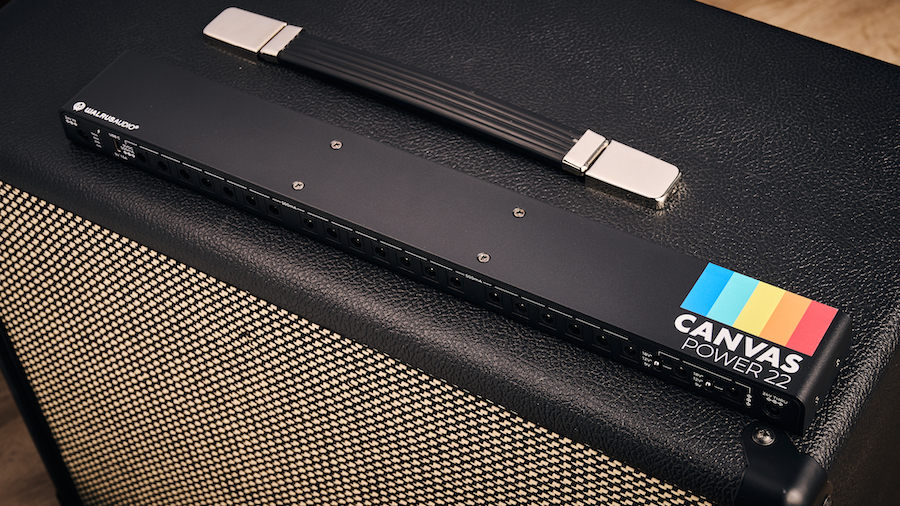

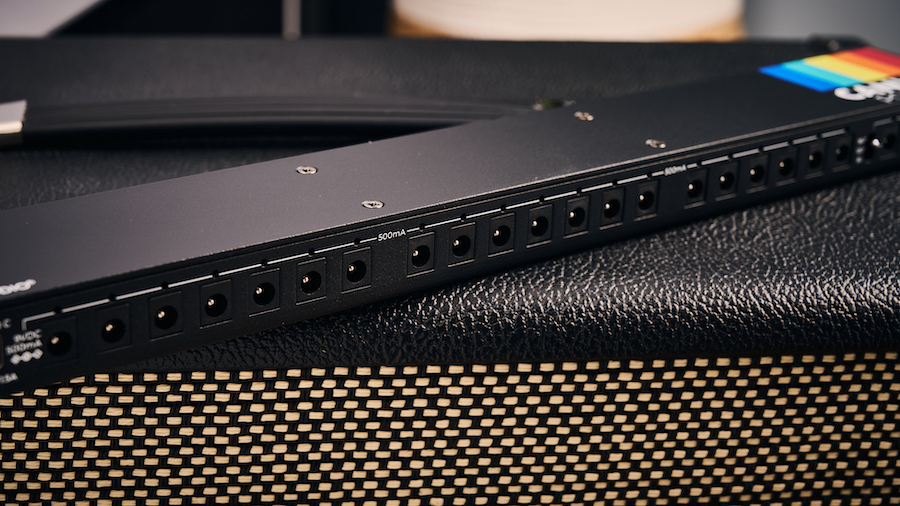
Specifications
Reasons to buy
Reasons to avoid
✅ Buy if you're a pedal hoarder: With a full 22 power outlets, this is one for the guitar players who have monster pedalboards.
❌ Avoid if you prefer switchable outlets: Considering the amount of outlets here, I'm surprised there aren't more switchable outlets, as players with large collections could have some unique power requirements.
What is it? There might not be a huge majority of guitarists out there who need around two dozen isolated outputs to power their mothership – but who amongst us hasn’t dreamt of such a humungous ‘board? And who amongst us wouldn’t, if given half the opportunity, take every step to make that humungous ‘board a practical reality? Well, Walrus Audio’s Canvas Power 22 is the full-stop answer to the semi-inevitable question: “how on Earth do I power my humongous ‘board, born of boundless avarice and unchecked ambition?”
Build quality: The Canvas Power 22 is a rare pedalboard power supply, in that it is wieldable. It’s a veritable baton, and one I couldn’t resist lightly brandishing before installing on my largest available pedalboard. Said light brandishing revealed the impressive solidity of the build, even for its relative lightness (most of the bulky power-regulating circuitry is outside the unit, housed in a laptop-style power adapter). Everything is neatly constructed, precisely assembled, and not too hard to look at either. Shame to hide this under your board; glad I kept mine on top for my testing!
Key features: The Walrus Audio Canvas Power 22’s key feature is in the name: it can power 22 pedals via 22 different isolated outputs. For most pedalboards, this is a frankly absurd level of redundancy – but for many still, this is an ideal solution. There are those of us with endlessly-growing studio-bound effects rigs, and fewer plugs to power everything with; there are those of us with expansive touring rigs that present a logistical challenge to power safely, let alone efficiently.
The Canvas Power 22 is an elegant, lightweight and low-profile problem solver here. Most of the outlets are 9V 500mA ports – juice enough for a majority of pedals – but two are switchable for your higher-voltage devices, and a power thru port means you can add even more outlets via additional Canvas power supplies.
Performance: My professional guitar practice has been, so far, a lesson in constraint – not just in how I play, but what I play with. I’ve prided myself on decimating my pedalboard size to achieve versatile sounds with less, simplifying my rig and minimizing my back pain between gigs. The Walrus Audio Canvas Power 22 has been the biggest challenge to my less-is-more journey, simply for trivializing the creation of a noiseless, maximalist pedalboard.
In practice, the Canvas Power 22 was a breeze to set up, never struggled even as I piled more into my setup, and stayed out of the way the whole time. Oh, and you can charge your phone mid-practice as well. As well!
Final verdict: The Canvas series is a real winner across the board, but especially so in this power-supply department. I love this thing for a number of reasons, above and beyond its sheer accommodatory kindnesses; in fact, the Canvas Power 22 narrowly misses the top spot in my guide purely for being – and I hope you don’t mind my paraphrasing Bender Bending Rodriguez here – a bit ‘too’ big, y’know?
Read more: Walrus Audio Canvas Power series review

"My Canvas Power 22 mega-rig didn’t quite reach max output capacity, mostly for practicality’s sake – but the 18 or so pedals I did run were remarkably happy with the power they received, as well as with one another. The handy LEDs that show you which outlets are supplying power are hugely helpful, particularly for tracking and troubleshooting."
Read more: Walrus Audio Canvas Power 22 review
Best for the studio
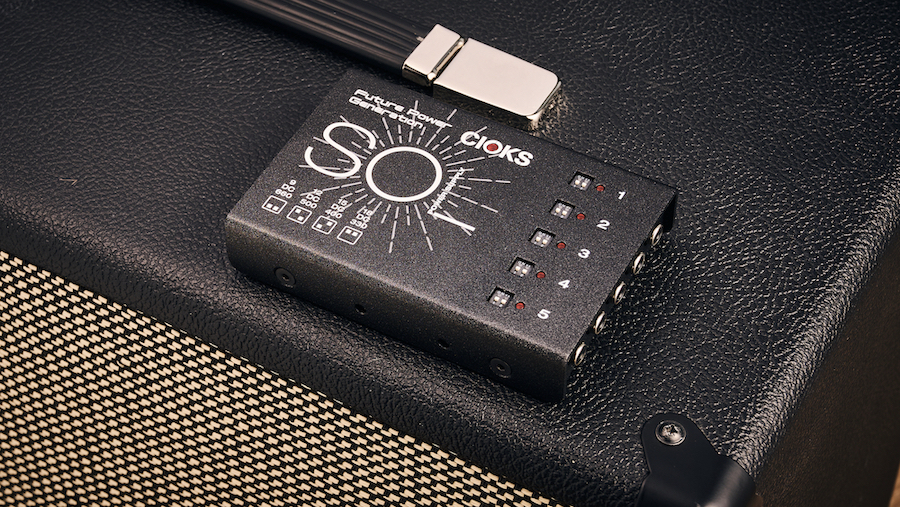
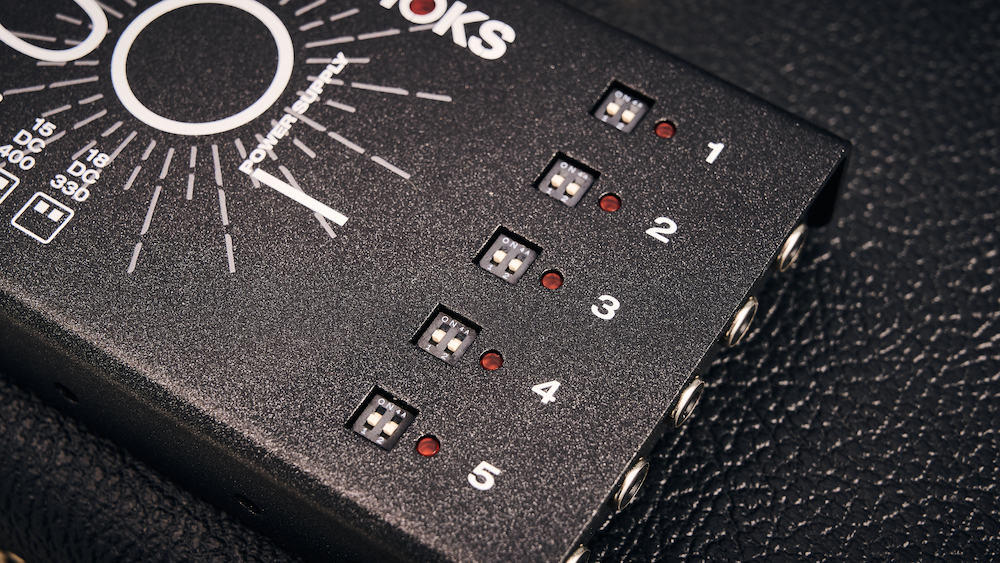
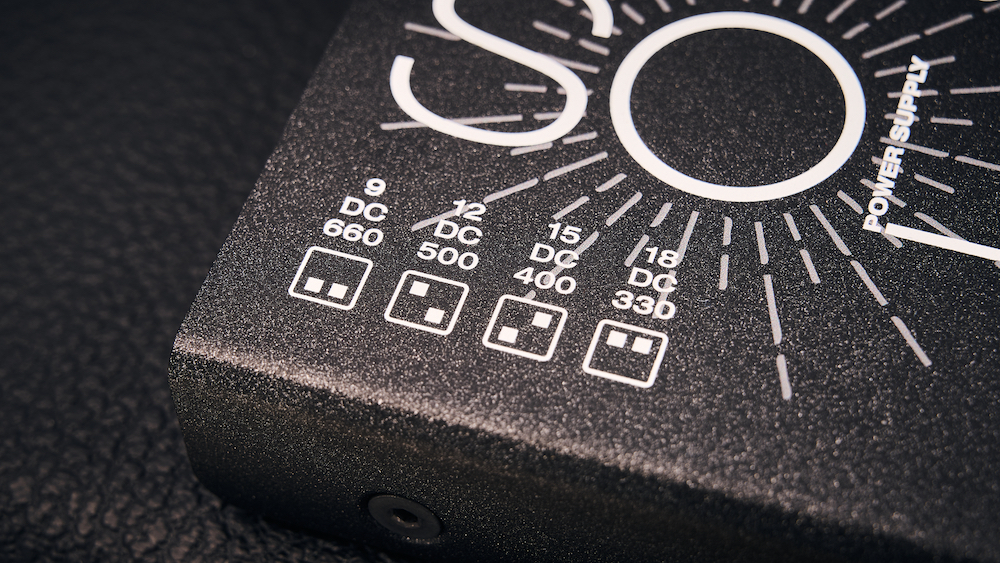
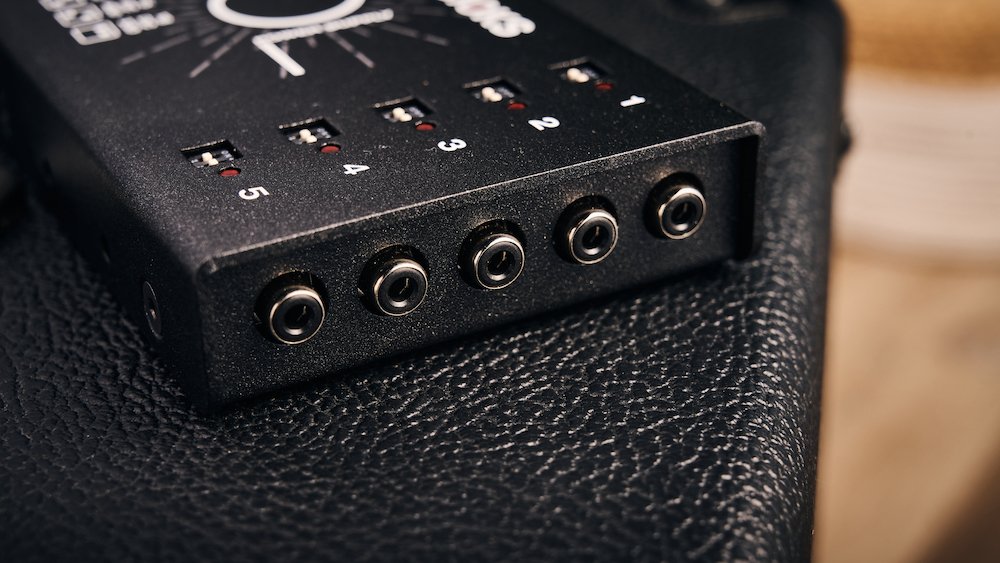
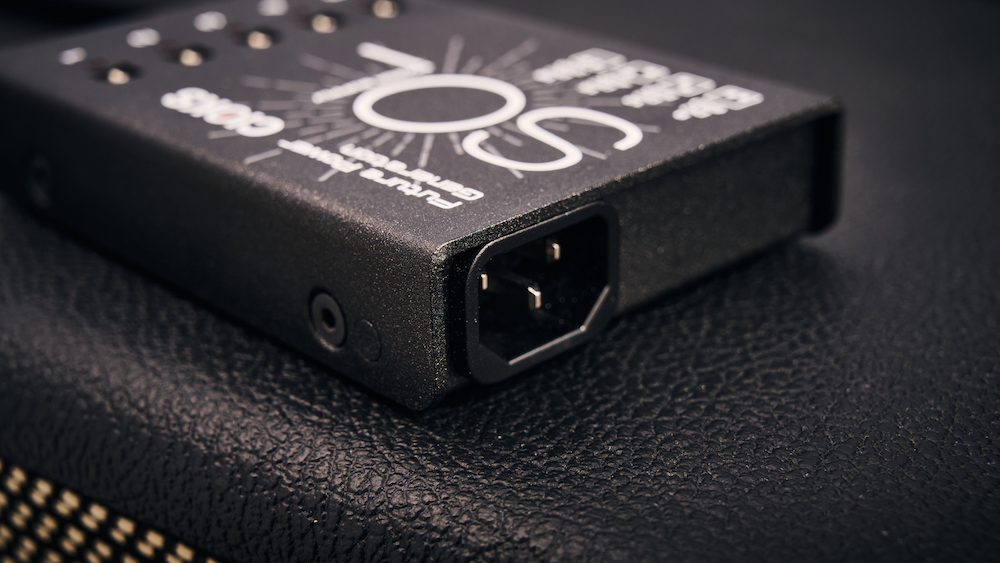
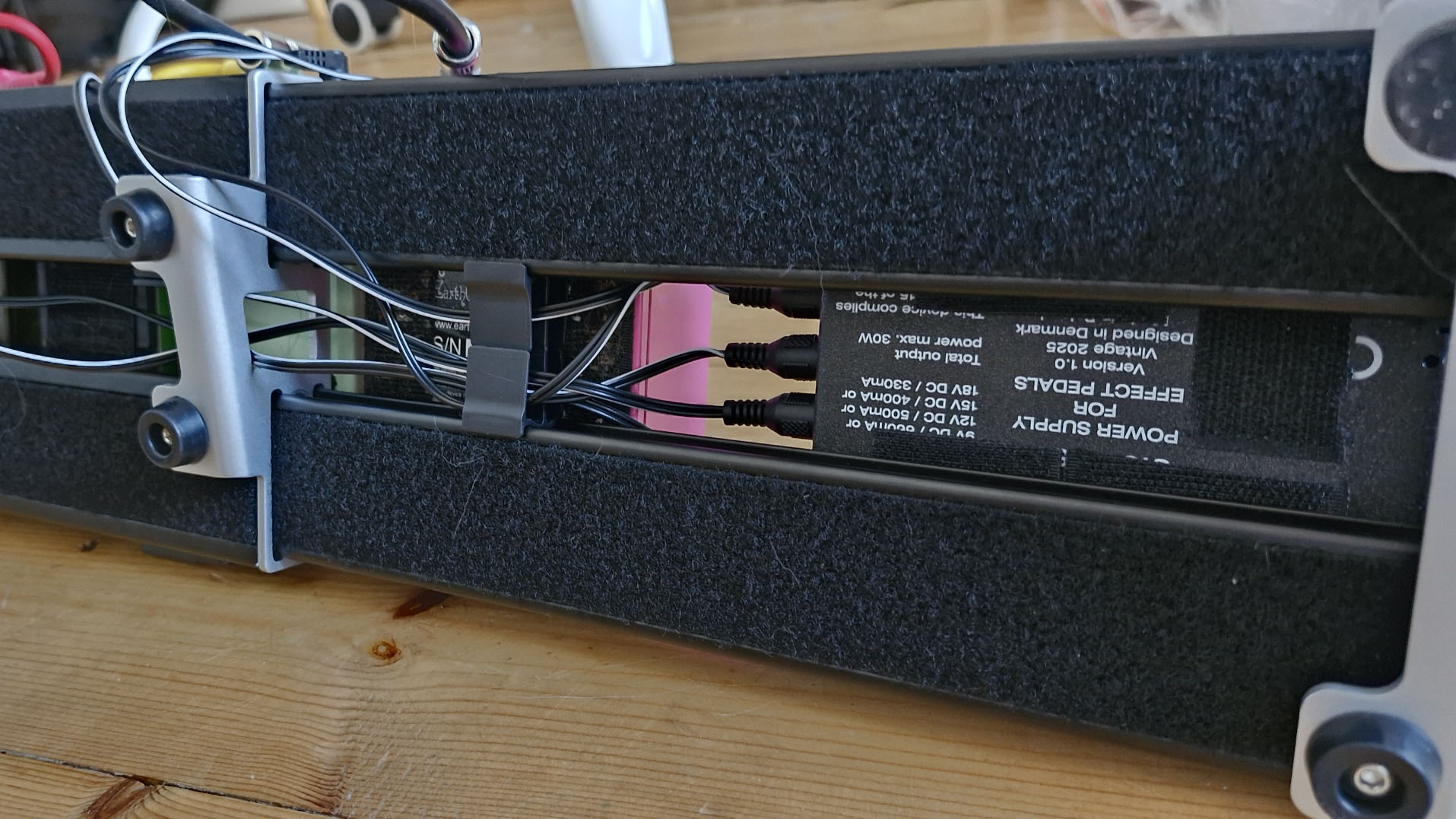
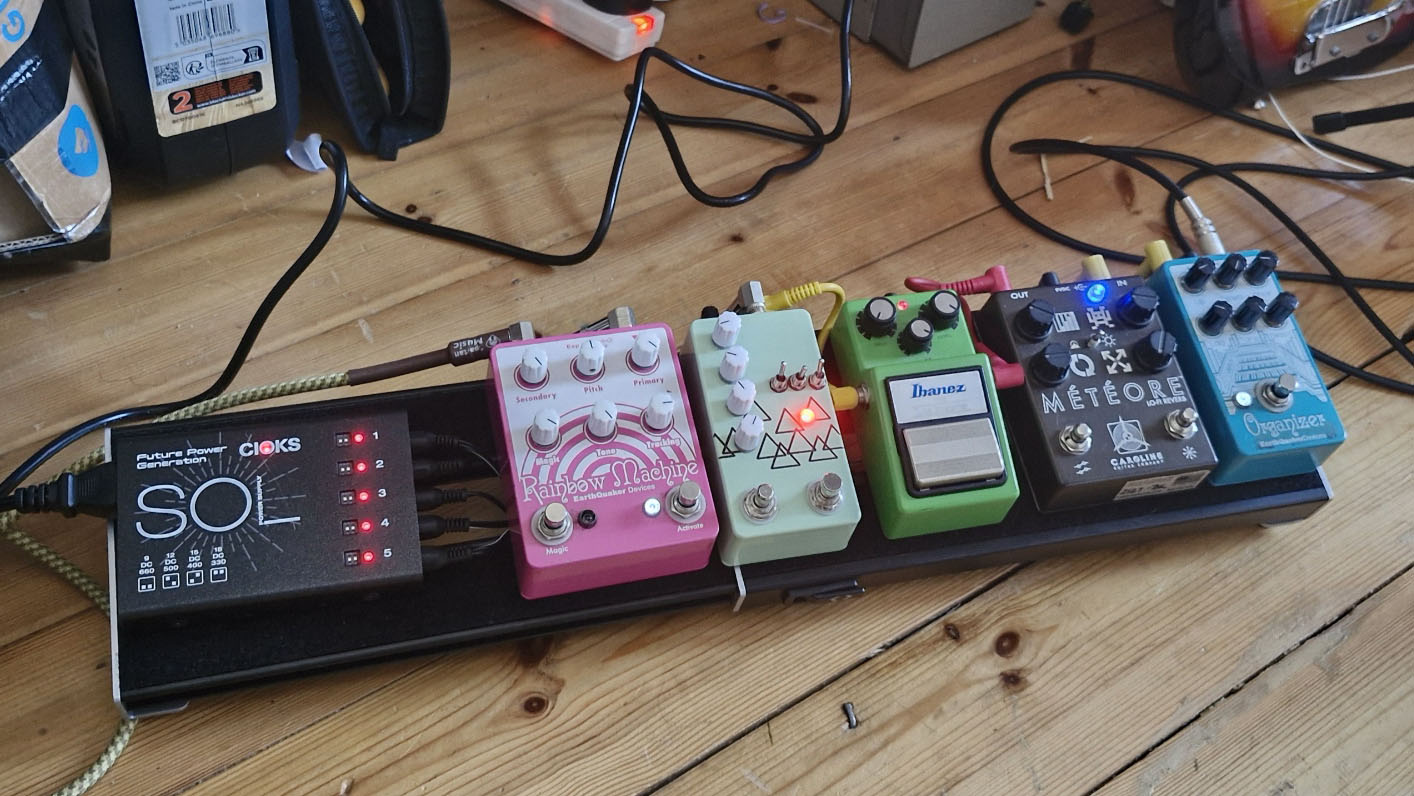
Specifications
Reasons to buy
Reasons to avoid
✅ Buy if you want a power supply that doesn't take up much space: This Cioks power supply is incredibly small, taking up very little room on your pedalboard while providing plenty of clean power.
❌ Avoid if you have a large pedalboard: This will only power five different pedals, so look elsewhere if you have a large pedal collection.
What is it? The Cioks Sol is a prodigiously adaptable pedalboard power supply from a pedal power supply-manufacturing heavyweight. Cioks has filled an essential gap since the early ‘90s, and continues to quietly nail the brief with its range of forward-looking juice-givers. The Sol is part of the Future Power Generation series – more specifically, the smallest in the range, designed to independently power up to five devices with some incredibly useful switch-y circuitry (more on which shortly).
Build quality: The Cioks Sol is a weighty little box, well-enclosed and pleasingly low-profile to boot. It’s demonstrably a toughie, with even its weaker points protected by some savvy design moves. The Sol hinges on your easy access to small plastic dip switches; these are recessed enough to avoid almost any incidental damage. The Sol also comes pre-loaded with some small adhesive-backed rubber feet – a nuisance to some, but extremely useful for me, particularly when you consider the sheer versatility of this thing.
Key features: The operative word for the Cioks Sol is ‘switch’; each of its five outlets accesses up to 660mA of juice, and can independently be switched between 9V, 12V, 15V and 18V, via two recessed dip switches. That healthful juice is supplied by a small onboard switch-mode power supply – which means your Sol is powered straight from the mains via a kettle lead, as opposed to via a bulky wall wart or laptop-style power adapter. For you, this means much less to carry – and a much simpler setup.
Performance: This small-format box-o-tricks first sat atop a small-ish pedalboard for recording with, and was highly capable at powering my handful of soundscape-y pedals. It could have fit underneath, but I preferred to have easier access to those tasty power-switchin’ dip switches while I was working with different effects units.
In order to do the Sol the juice-y justice it truly deserved, I briefly put it to work as a benchtop power supply too – where it supplied power to outboard effects pedals, my Critter and Guitari Organelle and an Omnichord for good measure (facilitated by the various different cable types provided with the Sol). And guess what? It worked silently, simply and flawlessly in my home recording setup. Those switchable power outlets are great for multi-format pedalboards, but greater still for ever-changing desktop working environments.
Final verdict: I love this thing. The Cioks Sol is a supremely useful pedal power supply in its own right, but all the more useful for its low-profile form factor. It’s quiet, clean, versatile and will hide right out of the way – all you want from a small-pedalboard power supply.

"I love this thing. The Cioks Sol’s low profile makes it an easy insert into any small pedalboard or studio setup. It slipped seamlessly into mine, giving me some fresh utility in the process, too. For me, this is a no-brainer – either as a flexible member of your pro-grade travelling rig, or as a steady desktop power supply for your home-studio writing and recording."
Read more: Cioks Sol Future Power Generation review
Best modular
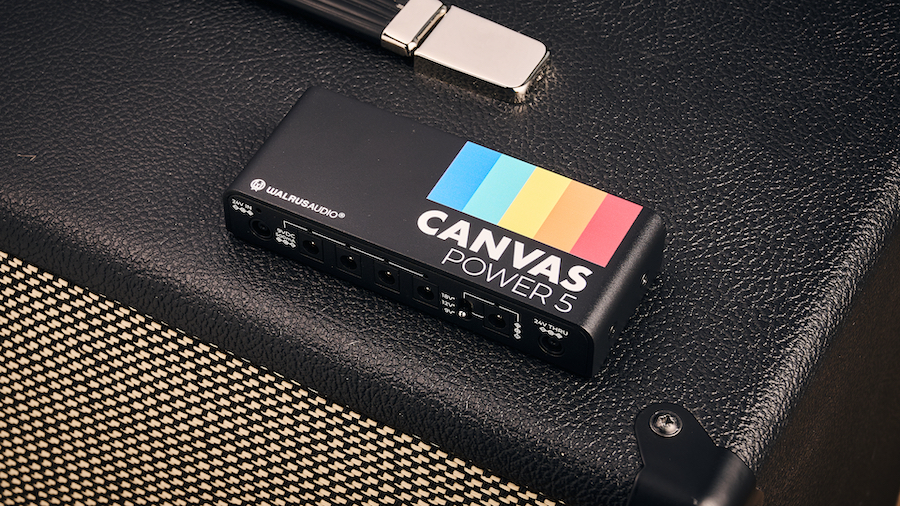
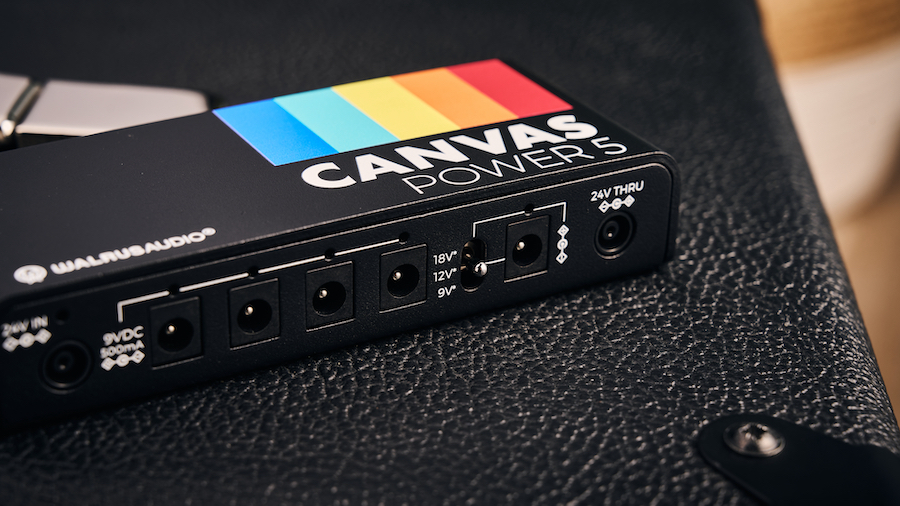
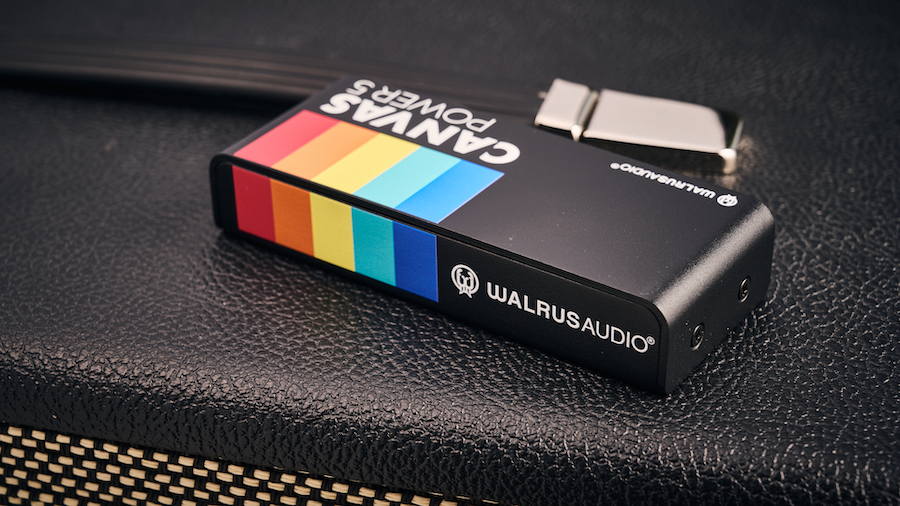
Specifications
Reasons to buy
Reasons to avoid
✅ Buy if you need to change your power requirements regularly: These power supplies are modular, which means they can be chained to one another as and when you need them.
❌ Avoid if you need USB outputs: These don't have USB outputs which can be handy for a variety of uses, whether that's powering additional pedals, running LEDs on your board, or just charging your phone when you need.
What is it? ‘It’, or more accurately, ‘they’ are another two entries from Walrus Audio’s excellent Canvas range of essential guitar utilities. The Canvas Power 22 has already made my list for its comprehensive powers-everything maximalism – but this maximalism doesn’t get to the core of what makes Canvas power supplies especially versatile. These – the Canvas Power 5 and HP – are the ideal vehicles for exploring Canvas’ incredible penchant for modularity.
Build quality: The smaller Canvas power supply units share the same strong attention to detail – and wider quality of build – as the Canvas Power 22, reviewed just a little bit further up. They have the same low profile and surprisingly-shallow depth, making them extremely easy to slip into your existing rig. They don’t seem to mind a bit of rough and tumble, either.
Key features: These Canvas power supplies share a key reason for which they collectively take this spot in my pedal power line-up; they demonstrate the Canvas series’ modular strengths incredibly well. These power supplies can be daisy-chained to one another via a proprietary link cable, meaning they can all be powered from one plug. Other pedal power supplies (including a few right here in this round-up) can do this too – but where Walrus Audio wins me is with the variety of ‘modules’ you can connect.
Two of those modules are the Canvas Power 5 and Canvas HP; the former provides 5 high-ish current isolated outputs, and the latter provides robust high-current outputs, including an extra-high-current one for your high-demand amp or effects emulator. With this, you could keep your flotilla of digital modulation workstations on a separate board, hooked up to a Canvas HP for clean high-current power, for easy appendment to your Canvas-powered daily-driver board.
Performance: I don’t have a flotilla of high-demand digital modulation workstations – but what I do have is the need for a parallel-processed guitar rig. I sometimes need an octave-down-y pedalboard to feed a bass amp alongside my usual guitar amp, or at least some parallel distortion for beefed-up dual-amp tone; words cannot express how convenient it is to have this auxiliary pedalboard powered cleanly via Canvas’ linking system.
The Canvas system isn’t just convenient, though; it’s quiet, too. Powering multi-output pedalboards while linked to the same single power adapter, there was never a hint of errant ground noise or parasitic digital noise. It just works!
Final verdict: The Canvas Power system overall is a great concept. Granted it isn’t the only modular pedalboard system out there, but it is one of the cleanest I’ve seen – not to mention the most versatile (outside of bespoke systems like GigRig). I love the idea that I could have disparate pedalboards, all linked up at a moment’s notice by a small handful of link and jack cables – and greatly enjoyed doing just that in my studio space, with my dual-amp setup.

"Usually, my soundchecks are a journey into the tangle of cables and power supplies dangling beneath my pair of ‘boards – and usually, there’s some intolerable parasitic noise generated by one pedal and haplessly amplified by another, which I’m forced to style out throughout a given gig. During my rehearsals, though, with two Power 5s and a Power HP all linked to one power adapter, there was an unusual and blissful clarity. Despite the obligatory fussing required by the setting-up of such an idiosyncratic rig, my signal chain felt, for once, simple."
Read more: Walrus Audio Canvas Power 5/5 Link/HP review
Spec comparison
Model | Outlets | Switchable Outlets | USB | Dimensions | Weight |
|---|---|---|---|---|---|
Fender Engine Room LVL8 | 8 | 2 | Yes | 42 x 244 x 91.3mm | 705g |
Ernie Ball Volt | 5 | N/A | No | 23 x 90 x 59mm | 250g |
Voodoo Labs Pedal Power 3 Plus | 12 | 2 | No | 38 x 152 x 89mm | 450g |
Walrus Audio Canvas Power 22 | 22 | 2 | Yes | 25.5 x 417 x 54mm | 572g |
Cioks Sol Future Power Generation | 5 | 5 | No | 25.4 x 130 x 88mm | 410g |
Walrus Audio Canvas Power 5/5 Link/HP | 5 (3 by link) | 1 (1 by link) | No | 25.4 x 133 x 54mm | 186g |
Also tested
The above power supplies should have most of the bases covered when it comes to powering your stompboxes, but if for any reason you didn't find what you were looking for there, here are some more great options for you to look at.
Strymon Ojai
The Strymon Ojai is a dinky thing, but great for expanding your existing Strymon power rig – or could be the ideal power supply for your small-but-sweet all-digital workhorse pedalboard.
★★★★☆
Strymon Zuma
Strymon’s Zuma power supply is an extremely capable unit, with isolated high-current outputs for pedals of practically any need. That blue’s a pretty one, too.
★★★★☆
MXR DC Brick
MXR’s DC Brick is a pedal-power mainstay – and one which just gets better and better. This iteration has 8 isolated 9V outputs and two 18V outputs, for quietly and assuredly handling the biggest ‘small’ boards going. The form factor and outlet placement make it great for sequestering away in small and awkward underside spaces.
★★★½
Rockboard ISO Power Block V6+
Warwick’s Rockboard-series power block offers five switchable-voltage DC power outlets (and a spare 5V USB outlet) at a tantalizingly accessible price point. I found it to be small, very lightweight and no fuss to use whatsoever; the flat power cables supplied alongside are a nice touch for installing, too.
★★★½
How to choose the best pedalboard power supply for you
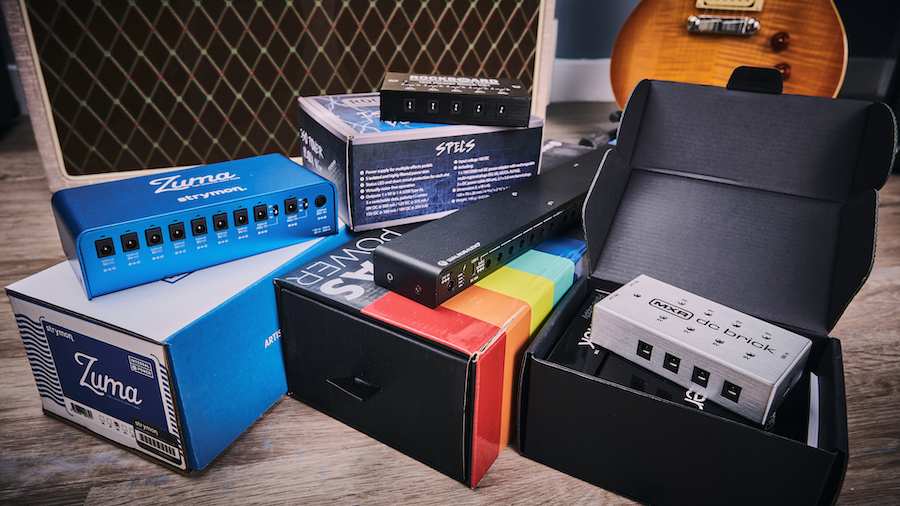
If you’re reading this guide, chances are you’re trying to find the best pedalboard power supply for your needs. There are several things you should consider before buying:
1. How many pedals are you using?
You can trust Guitar World
Here’s a fundamental one: how many pedals are on your board? And how likely is that number to grow in the not-too-distant future? Chances are we’re all answering ‘yes’ to that second question, but the first one is your starting point for how big a pedalboard power supply you need. It’s always good to have some spare power outputs for redundancy, but if you’re only powering a handful of essential pedals then you can afford to think smaller.
2. What’s your pedalboard for?
You’ll have different needs from a pedalboard power supply if you’re an active, gigging guitarist with international tour dates on the horizon than you will if you’re playing in the studio or at home. As a recording guitarist or at-home noodler, you might value adaptability more than anything; with a frequently-changing pedalboard, you’ll want a power supply that can adapt too, perhaps with more switchable outputs so you can meet the power demands of different pedals.
As a touring guitarist, you’ll be less interested in shuffling pedals around, but more interested in bombproof construction. You’d also benefit more from power supplies with universal mains input – meaning your pedalboard will play ball with practically any mains voltage around the world – and additional USB power outputs, either for charging your phone during soundcheck or powering a small light so you can actually see which pedal settings you’re fiddling with.
3. What are your power needs?
It’s all well and good knowing how many pedals you might want to power, but you’ll also need to think about how much power they actually need. Digital pedals are higher-demand than analog pedals, and will need high-current outputs to work properly; some pedals can have weird voltage requirements, too.
Look at each of your pedal’s power requirements, to make sure the power supplies you’re looking at can meet them all. Current demands quite literally add up, so a good starting point could be to add up the maximum current demands of each pedal and checking it against the total ‘current capacity’ of the power supplies you’re looking at.
4. Where’s it going on your pedalboard?
You might have an angled or tiered pedalboard, and hence be able to mount your power supply on the underside to leave more room for pedals – in which case, you need to know how much clearance there is. Some pedal power supplies might simply be too tall or deep to properly mount underneath! If you’ve a flat pedalboard with no underside space, then your pedal power will unavoidably need to share real estate with your actual pedals – and may need to be smaller or lower-profile as a result.
5. Will you be expanding your pedalboard?
In the longer term, you might ultimately find yourself doubling the size of your pedalboard, or even building a second one as part of a modular rig. Choosing a modular-capable pedal power supply now could save you some major headaches in the future; many brands have daisy-chain-able power supplies that draw from the same mains input, allowing you to expand your power outputs with minimal fuss.
FAQs
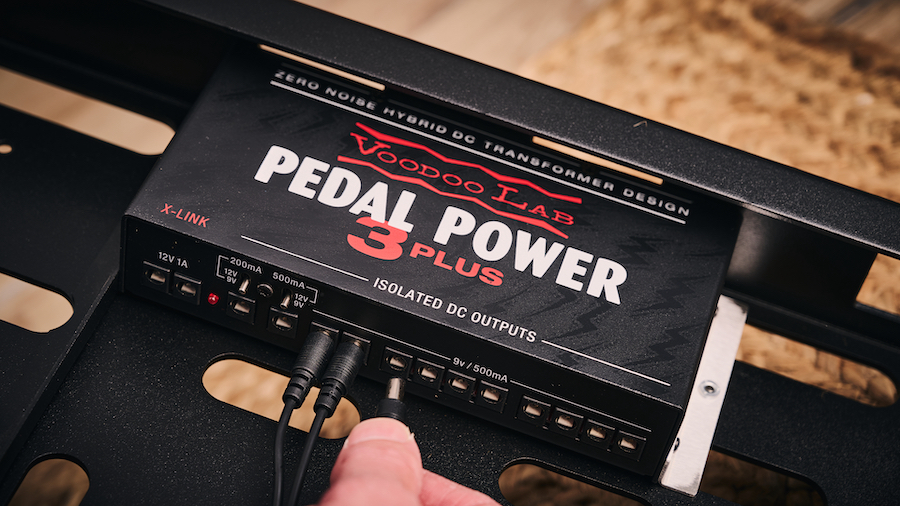
Why do I need a pedalboard power supply?
You need a pedalboard power supply because, quite simply, guitar pedals need power! Except for a small handful of signal-switching or -killing utility pedals, guitar pedals contain active circuitry that needs juice to work its magic.
Some guitar pedals are nice enough to come with their own power supply, but not all do – besides, if you want to build a pedalboard, how convenient is it to need a dozen power plugs every time you set up? Likewise, many pedals are content to run on 9V batteries, but buying and replacing these as often as you would have to doesn’t sound convenient or even fun.
Luckily, there’s an easier way; a good pedalboard power supply will provide convenient, clean and reliable power to several pedals at once, and only use a single power outlet while doing so. Your pedal power can be mounted on or even under your pedalboard, permanently hooked up to all your pedals and keeping everything tidy. With a power supply, your whole pedalboard becomes plug-and-play. requires only one cable from the mains supply, which it then distributes to your pedals.
What is an isolated pedal power supply?
Isolated pedalboard power supplies are power supplies where each individual output is physically and electrically disconnected from one another. Isolation transformers are used for each output, to decouple them from the power circuit in the power supply.
This has huge advantages for quality of power and for reduction of noise; in non-isolated power supplies like your old-fashioned daisy-chain, digital noise can be transmitted through the power lines and interact with other pedals, and ground loops can cause uncontrollable hum. Isolated power supplies do come at a higher price point, but I would always recommend buying isolated if possible – which is why my above list entirely comprises isolated power supplies.
What power supply do I need for my pedalboard?
The best pedalboard power supply for you will be entirely dependent on the types of pedals you use. If you use mainly analog stompboxes, then your requirements may be fairly simple. Analog pedals have a low current (mA) draw, and typically all look for the same 9V center-negative supply. Digital pedals are a little more demanding, particularly with current – if your ideal pedalboard is awash with Meris or Strymon pedals, you’ll need a power supply with high current capacity.
Some pedals use different voltages – typically 9V, 12V, 15V, or 18V. These different voltages are highly useful for incorporating some digital pedals that are fussier about power, but also give you options elsewhere! For instance, a not-inconsiderable number of analog pedals can run on either 9V or 18V, with pedals like the Fulltone OCD enjoying more headroom at 18V.
When buying a pedalboard power supply, you might find it beneficial to have different voltage options on tap, even if just to ensure you aren’t limited when buying pedals in the future.
How much power do I need for my pedalboard?
No two pedalboards are the same, and neither will they have the same power requirements. On a basic level, there’s the number of pedals on your board. Smaller pedal power supplies will have four or five power outputs, but larger ones will offer as many as 22. The more pedals you have, the more individual outputs you’ll need. But each of your pedals could have different power requirements, meaning we need to look past your pedal count.
Thinking back to high-school electronics, you might remember that P=IV – that is, power equals voltage multiplied by current. As such, we need to consider both with respect to your board! Voltage is easy. Most pedals ask for 9VDC, and this is what all power supplies will provide; some pedals are a bit needier, so if you have a pedal that’s asking for 12V, 18V or even 24V you’ll want to select a power supply with the requisite outputs. Current, though, is the one that can trip people up.
Pedals draw current according to their needs, and some needs are greater than others – especially when it comes to digital pedals, which have higher current demands than analog pedals do. Your power supply needs to be beefy enough that all your pedals can draw current without something going wrong, or worse, going ‘bang’. If your board is mostly digital, you’ll need a power supply with high-current outputs.
Do guitar pedals use AC or DC power?
The vast majority of guitar pedals are expecting DC power, and this is what the vast majority of pedalboard power supplies are here to provide. DC stands for direct current, and refers to the flowing of electricity in one direction – a stable and consistent form of power which is utilized by most guitar pedals.
AC stands for alternating current, referring to the oscillation of electron flow direction. There are some pedals that look for AC power as opposed to DC, often because they use valve technology (like the Blackstar HT Drive) or otherwise have their own power-rectifying circuitry inside (like the Digitech Whammy). There are pedalboard power supplies that offer AC outputs, but these are less common; if you only have one AC-powered pedal, it might be more convenient to power it separately with the power supply it came with!
Can a pedalboard power supply damage my pedal?
With the right kind of power from a good pedalboard power supply, your pedals are perfectly safe. Cheaper pedal power might not protect your pedals from power surges, but with a higher-quality supply, your only concerns are really with user error! Voltage is the primary source of potential pedal damage, as opposed to current – which poses potential risk to your power supply more than your pedals.
Apart from with select analog effects, pedals that see a higher voltage than they’re expecting will fry. The vast majority of pedals are 9V, but some power supplies have switchable voltages, so be sure you have the output set to the right voltage before plugging in your pedal.
No matter which pedal you’re powering, the wrong polarity voltage will almost-certainly break it. Polarity is, essentially, which lug of the power plug carries the positive voltage and which is the ground return. Most pedals are center-negative, meaning the tip of the barrel plug is ground, but some are center-positive – and either way, using the wrong polarity is causing electricity to flow the wrong way.
To know which is which, look for a symbol on your pedal and on the power supply output; there should be a plus and a minus sign, each in a circle, with a line from each approaching one another. Center-negative power would show the line from the minus sign culminating in a dot, and the line from the plus sign culminating in a C-shape encircling the dot. Center positive would be the other way around.
Is it OK to power my pedals with a daisy-chain?
Daisy-chaining is when multiple pedals share the same power output. Cheap and basic power supplies are often daisy-chains, and often the source of noise in many growing pedalboards too! Daisy-chained pedals share the same ground for power, which can enable noise to leak over to other pedals, particularly if you have digital pedals in your signal chain. The discrepancy between the power supply’s ground and your guitar signal’s ground can also introduce nasty ground loops, meaning hum or buzz in your signal.
As bad a reputation as daisy-chaining has, though, it is absolutely fine for simple signal chains that use analog guitar pedals. Just make sure that your pedals’ total current draw doesn’t exceed the capacity of the output you’re daisy-chaining from, or else your power supply will suffer.
How do I install a pedalboard power supply?
Electrically speaking, installing a pedalboard power supply in your setup is as simple as connecting the power outputs to your pedals’ power inputs (taking care, of course, to match voltage and current requirements with each output), then plugging your power supply into an electrical outlet. The hard bit is finding space for it on your pedalboard!
Pedalboard power supplies range in sizes, but are often unavoidably a little bulky. How to install them depends on where you might have space available. Angled pedalboards, like most Pedaltrains, have space underneath where you could strap your power supply – and many power supplies have mounting kits too, that are either compatible with certain branded pedalboards or ‘universal’. Alternatively, or for flat pedalboards with no underside space, you could attach your power supply just as you do with any guitar pedal – a healthy length of Velcro!
Key terms
Stuck on some of the terminology in this guide? Here's a clear explanation of key terms relating to power supplies and what they mean:
- 9V / 12V / 18V / 24V: These numbers refer to voltage, measured in volts (V). Voltage could be analogized as the ‘pressure’ in an electrical circuit. Guitar pedals expect a specific voltage from their power supply to work properly. The vast majority are looking to receive 9V, but some may have higher requirements – digital multi-effects pedals often ask for 12V or 18V, and some high-demand pieces of kit may even ask for 24V.
- 100mA / 300mA / 500mA: These numbers refer to electrical current, measured in milliamps (mA). Current is the flow of electricity through a circuit, proportional to the ‘pressure’ behind it (see 9V / 12V / 18V / 24V) and the resistance posed by the wires and components.
- AC: AC stands for Alternating Current. The electricity you receive from your domestic power sockets is AC, and your pedalboard power supply receives this mains AC power in order to divide and condition it for your pedals. Most pedals require DC power to work, but some pedals require AC power, and that you use the proprietary power supply that comes with them.
- Analog: Analog guitar pedals are so named for the way they treat your guitar’s signal – namely, keeping it in its analog audio state, where it is a continuous fluctuating voltage. Your audio signal is preserved from start to finish, albeit manipulated heavily by the pedal’s circuitry.
- Capacity: Capacity is used to refer to the capability of your pedal power supply with respect to current. Pedals draw current from the power supply according to their needs; if a power supply doesn’t have enough capacity to provide for those pedals, your pedals may malfunction or your power supply could break.
- Center-negative/positive: See polarity.
- Current draw: Current draw is the ‘demand’ a pedal creates for current from a pedalboard power supply. Power supplies will list the maximum current that can be drawn from each output; as long as each pedal you plug in has a lower draw than the given capacity, your pedals and power supply will work just fine. If a pedal draws more than the power supply can provide, either the pedal or the power supply could malfunction.
- Daisy-chain: Daisy-chaining is the connection of multiple devices in series, powered by a single power source. Multiple pedals may be powered from the same individual output, or multiple power supplies may connect to one another to use the same mains input.
- DC: DC stands for Direct Current, referring to electricity which flows in one direction. Practically every guitar pedal requires DC power to operate, bar a handful of specific devices that look for AC power. As such, most every pedalboard power supply will supply predominantly DC power outputs for your pedals.
- Digital: Digital guitar pedals convert your guitar signal from analog audio signal to a digital signal; rather than being kept a continuous fluctuating voltage and manipulated by electronic components, your signal is effectively translated into ones and zeros by an ADC (analog-digital converter), before being manipulated by code and converted back into an analog signal.
- Draw: See current draw.
- IEC: IEC stands for ‘International Electrotechnical Commission’, and refers here to IEC60320 – a standard of mains electrical cable that you’ll find supplying most isolated pedalboard power supplies. There are a few different standards which will be familiar to you, but two you’re likely to come across are C7/C8 (or ‘figure-8 plug’, like the ones that power your PlayStation) and C13/C14 (or ‘kettle lead’).
- Isolated: Isolated power is effectively decoupled from other power circuits, by way of a transformer. In isolated power supplies, there are no direct connections between any of the outputs going to different pedals; this reduces noise in your pedalboard, ensuring each pedal receives clean power and ultimately that your tone remains pristine.
- Kettle lead: A colloquial term for a type of IEC power cable (see IEC), earned from the ubiquitous British kitchen appliance that once made handy use of the standard! You’ll find these supplying mains power to your amp, and potentially to your nice shiny new pedalboard power supply too.
- Polarity: Pretty much every guitar pedal receives its power via a barrel plug, which has a sleeve and a central tip. Center-negative pedals need the tip to connect to the power supply’s ground, and the sleeve to connect to the positive voltage rail; center-positive pedals are the other way around, where the tip connects to the positive rail and the sleeve connects to ground. Most pedals are center-negative, and pedalboard power supplies are center-negative as standard, but you should always check which polarity your pedals require before plugging them in; plugging the wrong polarity of power in, in either case, will almost certainly break your pedal.
- Transformer: Transformers are electrical components that manipulate electricity using the principle of induction. Transformers are used to take mains electricity and step it down to a voltage the following circuitry expects; in pedal power supplies, transformers are also used as decoupling devices to isolate individual pedal power outputs from one another.
How I tested the products in this guide
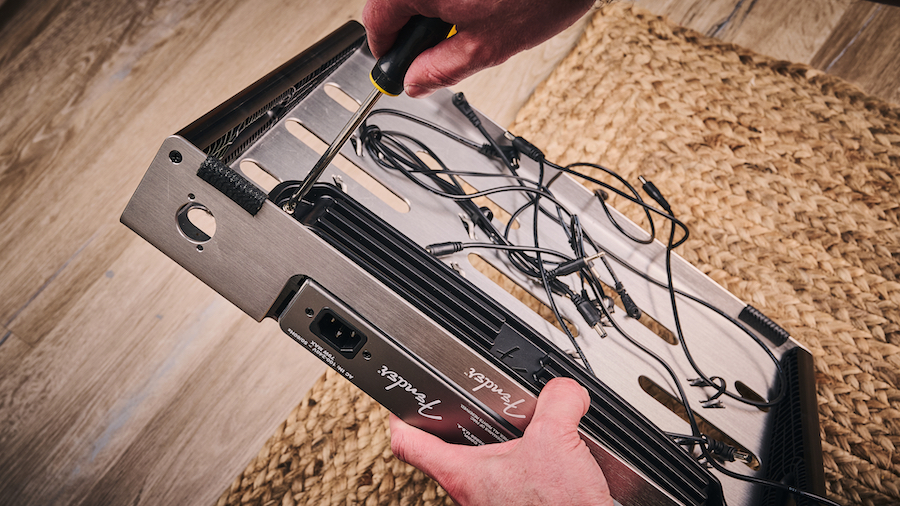
Pedalboards are an indispensable part of my practice as an active, gigging musician and recording artist. I play widely and eclectically too, meaning my pedalboards are often chopped and changed to suit the needs of the project at hand. On the recording side of things, I use my guitar-y knowledge to inform signal chains for the musicians I work with, as well as to use unique outboard effects chains in my production.
Testing these pedalboard power supplies, then, was as simple – and as complex – as introducing them to my day-to practice in writing, recording and rehearsing. Each of the power supplies I reviewed got their day in the sun, actively powering various different types of pedalboards for use at home, in the studio and during live gig rehearsals.
But what was I testing for? Well, first I evaluated the specs and features of each power supply, considering how they would apply to my own use cases. Some power supplies have different feature-sets and gimmicks, from 5V USB power ports for phone charging and pedalboard lighting to switchable voltages for powering pedals with different demands.
That said, the key attributes possessed by a good power supply are found more in the absence of things than the presence of things – for instance, the absence of digital noise sneaking into your audio signal, or the absence of any digital-effects gremlins relating to inconsistent or inadequate power. To borrow from Arrested Development, a great power supply is neither seen nor heard.
Each pedal power supply spent time powering a pedalboard I was actively using, and in a variety of different situations. I paid attention to the build quality and interface while installing them; during use I was looking (and listening) out for any problems with the delivery of power, while considering how easy each power supply was to set up and interact with. My opinions of each pedalboard power supply, in short, were formed from active use of each in my usual day-to-day guitarist/producerly practice.
Read more about our rating system, how we choose the gear we feature, and exactly how we test products at Guitar World.
Why trust us
✅ A global audience of 3.8 million guitarists monthly
✅ 1,200+ reviews on GuitarWorld.com
✅ 30+ years of product testing at Guitar World
Guitar World boasts over 44 years of expertise and stands as the ultimate authority on all things related to guitars. The magazine and website feature expertly written gear round-ups and top-quality, authoritative reviews penned by a team of highly experienced industry professionals.
Guitar World's inaugural print issue hit the shelves in July 1980, and ever since, it has been captivating players and enthusiasts with engaging lessons, insightful interviews with the most prominent guitar heroes, and priceless buying advice for newbie players.
Furthermore, GuitarWorld.com continues this legacy online and serves as the hub of the world's foremost authorities on guitar playing. The site not only hosts content from Guitar World but also showcases articles from respected publications such as Guitarist, Total Guitar, Guitar Techniques, and Bass Player. With a reach extending to 3.8 million players each month, GuitarWorld.com is a go-to destination for guitar fanatics globally.
Latest updates
19/11/25: Each product entry now has an 'At a Glance' boxout, and where applicable, an 'Expert Verdict' portion for products with a review. A new spec comparison table has been added, and the how to choose and key terms sections have been reformatted to make them easier to read.
06/06/25: This guide has been overhauled from top-to-bottom. We called in over 10 pedalboards from a range of brands and our writer tested them thoroughly at home, in the rehearsal room and on stage. As a result we have more thorough and honest opinions on each product. We've also taken a huge range of photographs so you can see each product in detail, from our perspective. Finally, we've added in-depth how to choose advice, a frequently asked questions section and a glossary of key terms.
Related buyer's guides
- Best patch cables: tidy up your ‘board today
- Wired for sound: the best guitar cables
- 6 ways to improve the performance of your pedalboard
All the latest guitar news, interviews, lessons, reviews, deals and more, direct to your inbox!

James Grimshaw is a freelance writer and music obsessive with over a decade of experience in music and audio writing. He's lent his audio-tech opinions (amongst others) to the likes of Guitar World, MusicRadar and the London Evening Standard – before which, he covered everything music and Leeds through his section-editorship of national e-magazine The State Of The Arts. When he isn't blasting esoteric noise-rock around the house, he's playing out with esoteric noise-rock bands in DIY venues across the country; James will evangelise to you about Tera Melos until the sun comes up.
- Matt McCrackenJunior Deals Writer
